Kristine Hughes's Blog, page 72
August 7, 2015
THE DUKE OF WELLINGTON TOUR: WALMER CASTLE
THE DUKE OF WELLINGTON TOUR STORMS WALMER CASTLE, DEAL, AND DOVER CASTLE
We boarded our 'bus' outside the Grosvenor Hotel and met our wonderful driver Graham. As we learned over the next few days, he was a diamond of the first water among coach drivers -- remember not to call the vehicle a bus! We set off driving through London into Kent toward the Channel coast.
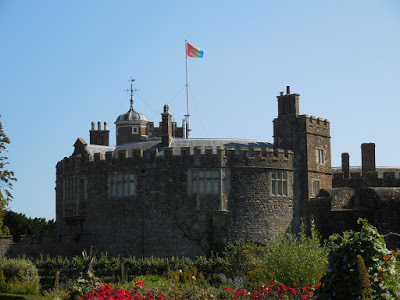 Walmer Castle, September 2014
Walmer Castle, September 2014
You will not be surprised to hear this blog has written of Walmer before. Here is our introduction to the visit on the Duke of Welington tour, in which we relate many facts about the Castle and the Duke's residence, including the visit of Lady Lyttleton, the very one you met last week on the St. James walk as once the lady of the building now known as the Stafford Hotel. Click here.
Victoria visits in 2011 here.
Wellington's life at Walmer here.
The Death of Wellington at Walmer here.
You can see all of my (Victoria's) pictures in the previous posts. Here are a few from Diane which will giver you a flavor of Walmer Castle and its lovely gardens.
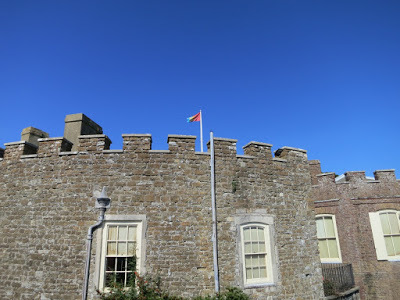
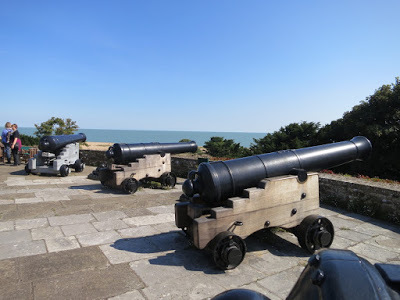
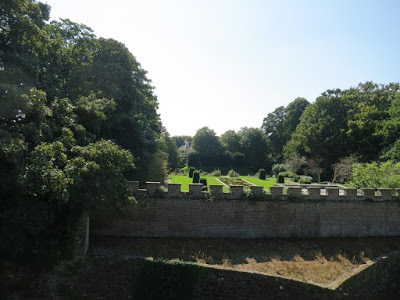
We made a quick stop; in Deal, not far from Walmer...and a larger town. Here is the beach, as photographed by Denise.
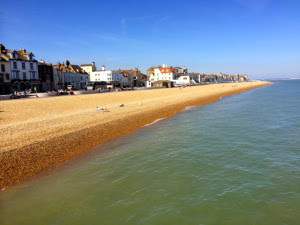
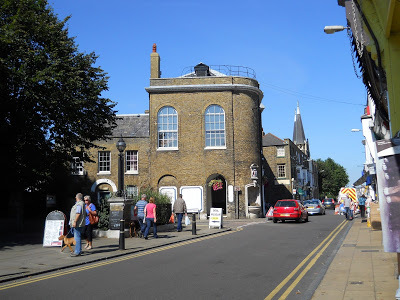 Elaine photographed the Town Hall, dating from 1803
Elaine photographed the Town Hall, dating from 1803
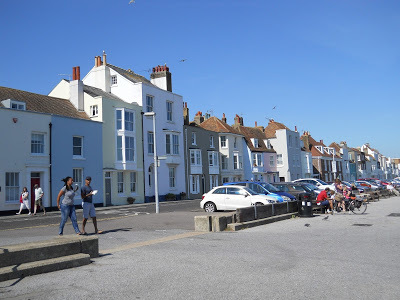 A row of 18th C. houses along the seaside, in one of which Admiral Horatio Nelson lived.Thanks, Elaine.
A row of 18th C. houses along the seaside, in one of which Admiral Horatio Nelson lived.Thanks, Elaine.
For more about Deal Castle, a larger version of Walmer, dating from the time of Henry VIII, click here.
Denise also shared some pictures of our final stop that day, at Dover Castle on the heights of the White Cliffs, here as seen from the Beach.
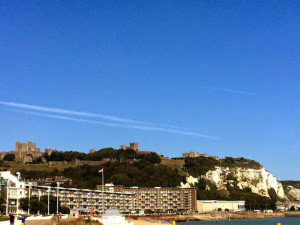
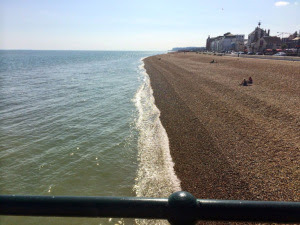
Denise and I shot almost exactly the same picture as we approached the walls of Dover Castle.
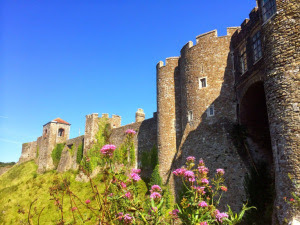 from Denise
from Denise
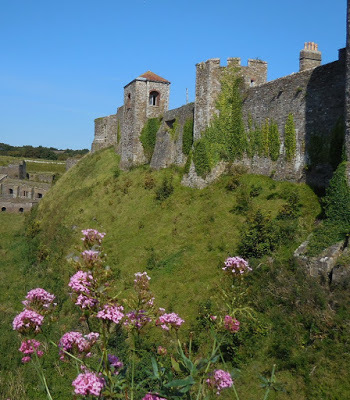 from Victoria
from Victoria
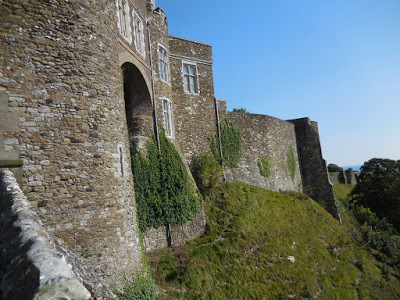
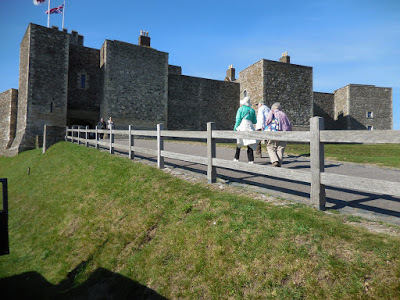 Tour-goers scaling the approach
Tour-goers scaling the approach
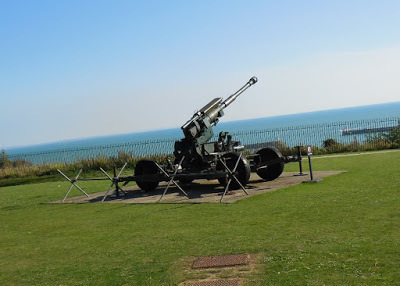 Modern weaponry still guards the channel and port
Modern weaponry still guards the channel and port
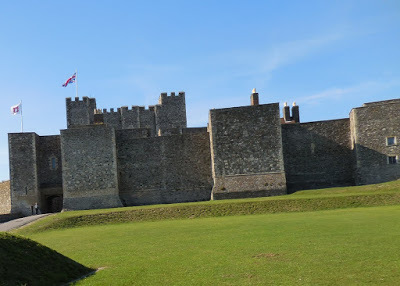 Formidable!!
Formidable!!
A visit to Dover Castle takes you from the time of King Henry II (1133-1189) to World Wars I and II, through medieval tunnels and secret modern wartime tunnels, from ancient armaments to today's garrison keeping watch over the English Channel and the important port of Dover.
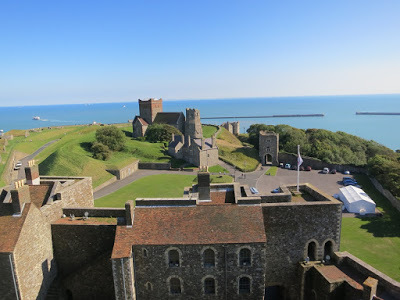 Diane's View from the Top
Diane's View from the Top
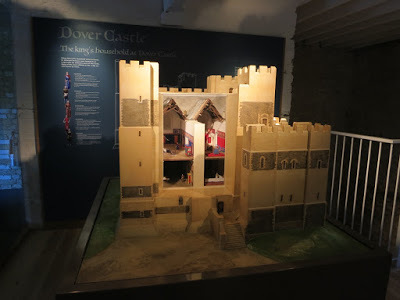 A model of the working castle fortifications
A model of the working castle fortifications
For more from Denise, click here.
For more from Diane Gaston, click here.
Dover Castle is maintained and programmed by English Heritage, which has an excellent website, click here.
We boarded our 'bus' outside the Grosvenor Hotel and met our wonderful driver Graham. As we learned over the next few days, he was a diamond of the first water among coach drivers -- remember not to call the vehicle a bus! We set off driving through London into Kent toward the Channel coast.
 Walmer Castle, September 2014
Walmer Castle, September 2014You will not be surprised to hear this blog has written of Walmer before. Here is our introduction to the visit on the Duke of Welington tour, in which we relate many facts about the Castle and the Duke's residence, including the visit of Lady Lyttleton, the very one you met last week on the St. James walk as once the lady of the building now known as the Stafford Hotel. Click here.
Victoria visits in 2011 here.
Wellington's life at Walmer here.
The Death of Wellington at Walmer here.
You can see all of my (Victoria's) pictures in the previous posts. Here are a few from Diane which will giver you a flavor of Walmer Castle and its lovely gardens.



We made a quick stop; in Deal, not far from Walmer...and a larger town. Here is the beach, as photographed by Denise.

 Elaine photographed the Town Hall, dating from 1803
Elaine photographed the Town Hall, dating from 1803 A row of 18th C. houses along the seaside, in one of which Admiral Horatio Nelson lived.Thanks, Elaine.
A row of 18th C. houses along the seaside, in one of which Admiral Horatio Nelson lived.Thanks, Elaine.For more about Deal Castle, a larger version of Walmer, dating from the time of Henry VIII, click here.
Denise also shared some pictures of our final stop that day, at Dover Castle on the heights of the White Cliffs, here as seen from the Beach.


Denise and I shot almost exactly the same picture as we approached the walls of Dover Castle.
 from Denise
from Denise from Victoria
from Victoria
 Tour-goers scaling the approach
Tour-goers scaling the approach Modern weaponry still guards the channel and port
Modern weaponry still guards the channel and port Formidable!!
Formidable!!A visit to Dover Castle takes you from the time of King Henry II (1133-1189) to World Wars I and II, through medieval tunnels and secret modern wartime tunnels, from ancient armaments to today's garrison keeping watch over the English Channel and the important port of Dover.
 Diane's View from the Top
Diane's View from the Top A model of the working castle fortifications
A model of the working castle fortificationsFor more from Denise, click here.
For more from Diane Gaston, click here.
Dover Castle is maintained and programmed by English Heritage, which has an excellent website, click here.
Published on August 07, 2015 00:30
August 5, 2015
WATERLOO WEDNESDAY: THE NAPOLEON MYTH SEEMS TO LAST FOREVER
THE NAPOLEON MYTH: WILL IT LAST FOREVER?
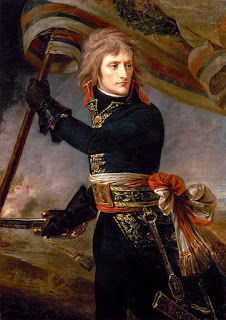
Victoria here. In 2010, when Kristine and I visited the battlefield at Waterloo for the 195th anniversary, we were struck by how little observance at the site there was for the victorious Duke of Wellington. Indeed in the gift shop, for example, there were busts of Napoleon, books, key chains, pictures, etc. etc. and nothing about Wellington.
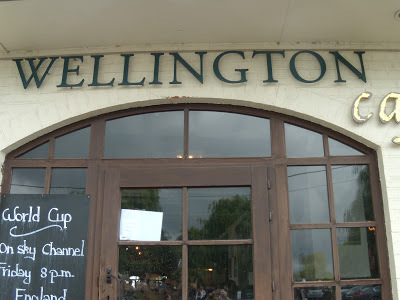
The one exception was a restaurant near the panorama building, and the advertisement for the beer. The logo for the beer is a reproduction of Lady Butler's famous painting of the cavalry charge of the Scots Greys, "Scotland Forever."
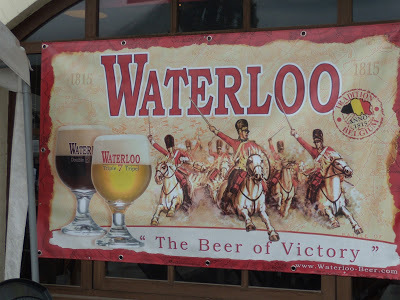
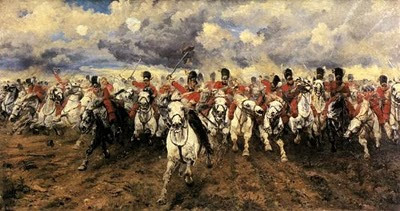 Scotland Forever! by Elizabeth Thompson, Lady Butler (1846-1933) painted 1881, Leeds Art Gallery
Scotland Forever! by Elizabeth Thompson, Lady Butler (1846-1933) painted 1881, Leeds Art Gallery
Even the text panels here and there on the Waterloo battlefield seemed almost apologetic that after the magnificent charges and maneuvers of the French troops, the British squares held and the Allies won. Friends attending the recent 2015 commemorations in Belgium reported that nothing had changed at the battleground or among the souvenirs. Such is the enduring myth -- for just one or two minor points Napoleon would have won, and even that he deserved to win.
Well, from my point of view that is all hogwash. You can add up all the IFS and UNLESSES, and the result is still the same Napoleon and the French lost the battle and were unable in the next few weeks to re-group their forces effectively to counteract the inevitable arrival of the Allies in Paris and the re-exile of Napoleon.
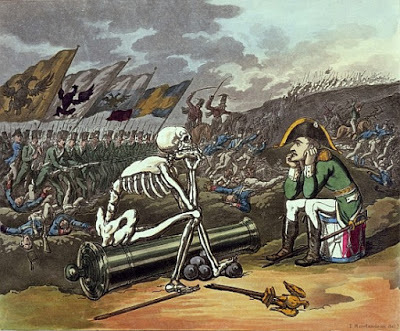 Rowlandson and the Battle of Waterloo's Aftermath
Rowlandson and the Battle of Waterloo's Aftermath
Thousands of casualties resulted from Napoleon's attempt to re-establish his empire. Though some writers have suggested he might have returned to Paris content to rule only France after his escape from Elba -- if only the Allies had not declared him an outlaw -- I think they are being incredibly naive. Once need only look at Napoleon's previous record to realize that was an ephemeral wish on the part of his apologists even two hundred years later.
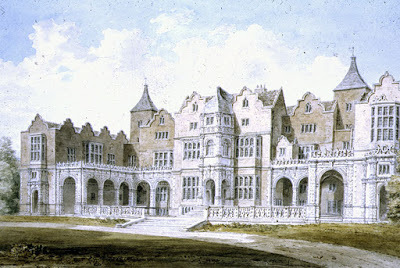 Holland House, London; center of Whig Politicians (1841)
Holland House, London; center of Whig Politicians (1841)
At the time of the battle and shortly there after, Napoleon had his rabid fans, even in England.
Many Whigs admired Napoleon, though some later changed their minds. Many members of the Whig Party in Great Britain had a pro-French position from the time of the 1789 Revolution right up to the re-burial of Napoleon. The Holland House Circle always seemed to find apologies for the excesses of the Revolution, and when it was clear that Napoleon was no longer advocating the republican ideals of he is early days and had become a dictator as Emperor, many Whigs were still on his side. Part of that, of course was opposition to the government of Tory-leaning Lord Liverpool.
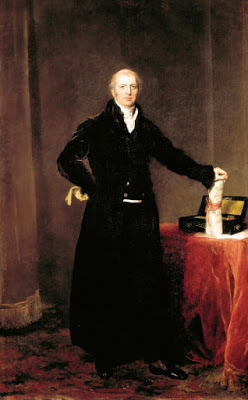 Robert Jenkinson, 2nd Earl of Liverpool (1770-1828)Prime Minister 1812-1827by Sir Thomas Lawrence, c. 1828
Robert Jenkinson, 2nd Earl of Liverpool (1770-1828)Prime Minister 1812-1827by Sir Thomas Lawrence, c. 1828
The first Whigs advocated the elimination of the Catholic Monarch James II and supported the Glorious Revolution that brought William II and Mary II to the throne. Throughout the monarchies of Anne and the first two Georges, the Whigs held governmental power. George III was more attuned to the Tory point of view which evolved under Prime Minister William Pitt the Younger. Whigs supported free trade, Catholic Emancipation, abolition of slavery, and some expansion of suffrage, though far from complete voting rights for all. Most Whigs believed that ownership of property should be required for voters.
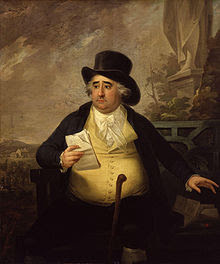 Charles James Fox (1749-1806) by Karl Anton Nickel, 1794, NPG, London
Charles James Fox (1749-1806) by Karl Anton Nickel, 1794, NPG, London
The Whig opposition to Pitt combined under Charles James Fox, son (then uncle) of two Lord Hollands. Though both parties were led by very rich landowners, the Whigs tended to support more aristocratic policies and the Tories, the gentry and emerging middle class, if one is allowed a sweeping generalization. The Tories favored strong central government control and the Whigs, in general, favored less reliance on governmental authority.
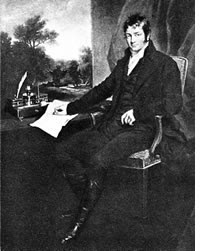 Samuel Whitbread II (1764-1815) by John Opie
Samuel Whitbread II (1764-1815) by John Opie
Samuel Whitbread (1764-1815), son of the wealthy brewer, and a Whig member of Parliament, was an advocate of Napoleon’s reforms in France. He was so depressed by the defeat of the emperor that he slit his throat in July 1815 and died. He had many companions in this admiration for Napoleon, though no one else was quite as extreme.
William Hazlitt (1778-1830) admired Napoleon for his “common” touch and found himself deeply depressed by the defeat at Waterloo. Late in Hazlitt’s life, he finally published a four-volume biography of the French man, meant to be his life’s crowning achievement. But it was a financial failure and he died before the final volume was published. Many other politicians and writers praised Napoleon and were sorry to see the Bourbons back on the throne of France. For a good concise account of the Whigs and Napoleon from Blogger John Tyrrell, click here.
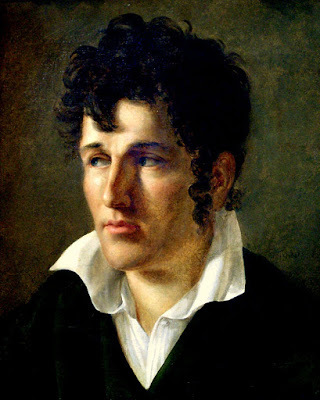 Francois-Rene de Chateaubriand (1768-1848) French politician and historianby Anne-Louis Girodet de Roiussy Trioson
Francois-Rene de Chateaubriand (1768-1848) French politician and historianby Anne-Louis Girodet de Roiussy Trioson
In his concise volume The Napoleonic Wars: A Very Short Introduction published by Oxford University Press, Mike Rapport quotes Francois-René de Chateaubriand’s memoirs from 1839, expressing his frustration with his contemporaries for ignoring – or forgetting the destruction and thinking only of the Gloire:
“It is fashionable today to magnify Bonaparte’s victories: those who suffered by them disappeared; we no longer hear the curses of the victims and their cries of pain and distress; we no longer see France exhausted, with only women to till her soil…we no longer see the conscription notices pasted up at street corners, and the passer-by gathering in a crowd in front of those huge lists of the dead, looking in consternation for the names of their children, their brothers, their friends, their neighbors.”
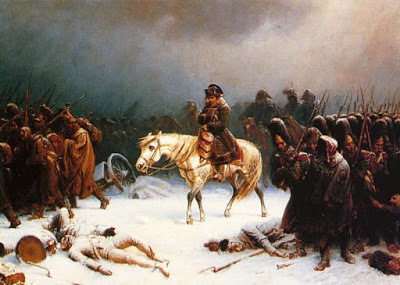 Napoleon in Russia 1812
Napoleon in Russia 1812
Napoleon’s memoirs as told to his secretary on St. Helena, Emmanuel de Las Cases, published shortly after the Emperor’s death in 1821, presented his version of his life story, emphasizing his victories and his goal to spread the values – Liberté, Égalité, Fraternité, French for "Freedom, equality, brotherhood", ofthe French Revolution – ignoring the fact he ruled as a tyrant and dictator. And caused the death of millions, from battle casualties, from the spread of disease, and from displacement and starvation.
Nevertheless, there is no shortage of apologists for Napoleon: Victor Hugo devoted a large section of Les Miserables to a recreation of his fanatsy victory at Waterloo. And Hugo has a monument at Waterloo!
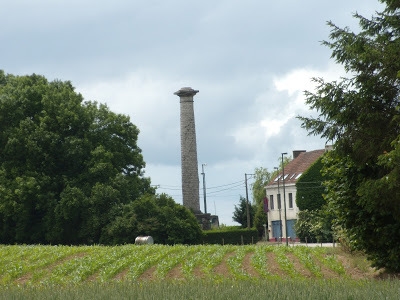 Victor Hugo Monument, Waterloo 2010
Victor Hugo Monument, Waterloo 2010
But to be fair, Napoleon’s reign brought many reforms and institutions which have endured for centuries. He put a final period to feudalism, and advocated the ideal of equality of all men (and later, women) which prevails in Western societies and has spread through much of the world. Equality and other concepts growing out of the Eighteenth Century Enlightenment – toleration, reason, the scientific process – were essential to the American and French Revolutions, and to the more evolutionary British philosophy of government.
Napoleon created bodies to put such concepts into practice in France. The Napoleonic Code made all men equal before the law, a gendarmerie enforced the law, and he promoted religious toleration. At first, Napoleon was eager to abolish aristocratic privilege, but in the end, he named himself emperor and ruled autocratically. However, he did uphold the idea of promotion by individual achievement, not family or wealth. Some of his generals came from the lowest rungs of society; others came from old families.
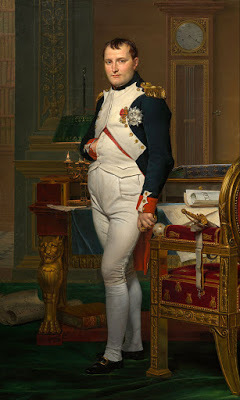 Napoleon Bonaparte by David, 1812National Gallery of Art, Washington D,.C.
Napoleon Bonaparte by David, 1812National Gallery of Art, Washington D,.C.
Many of us have lodged in our mind's eye, the images of Napoleon created by Jacques-Louis David (1748-1825), the great French painter of the Revolution and years of Napoleon. After the restoration of the Bourbons, David exiled himself to Brussels where he spent the rest of his life.
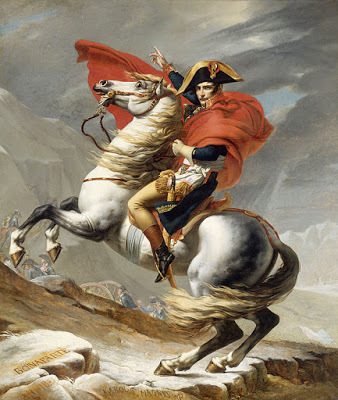 Saint Bernard Pass, 1801
Saint Bernard Pass, 1801
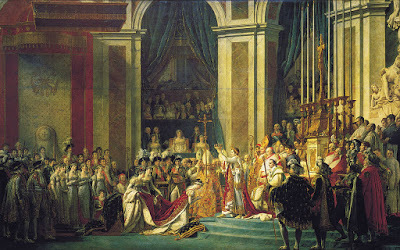 Coronation of Napoleon at Notre Dame, 1806
Coronation of Napoleon at Notre Dame, 1806
Though David's body is buried in Brussels, his heart is buried in Pere Lachaise Cemetery in Paris.
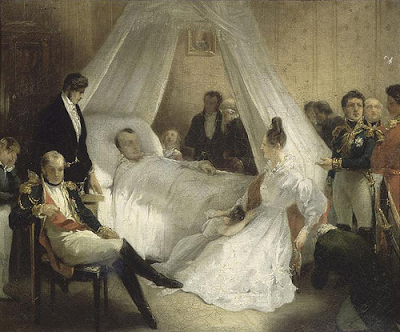 Death of Napoleon, 1821, by Charles de Steuben
Death of Napoleon, 1821, by Charles de Steuben
Napoleon was buried on St. Helena. In 1840, the British, the Whig government of Charles Grey being in power, allowed King Louis-Philippe of France to return Napoleon’s body to Paris where a grand state funeral was held. Twenty years later, his tomb was finished in Les Invalides.
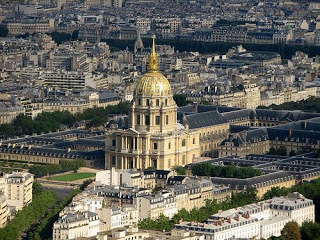
Hotel National Les Invalides, Paris
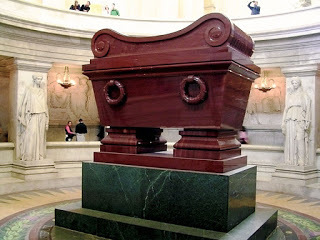 Napoleon's Tomb
Napoleon's Tomb
To read more about Napoleon's tomb and the museum, click here.
Napoleon scorned the re-reestablishment of the ancien regime in France and elsewhere, as decided by the Congress of Vienna. The Hapsburg Empire in Austrian eventually collapsed under its own weight, but the German-Prussian and Russian situations led to bloody war and excessive revolution,though not until many decades later.Some observers try to link Napoleon with the 20th-21stCentury movement for European integration, but I personally find that a bit of a stretch. The kind of integration he wanted was domination by France, by HIM, not a voluntary and gradual union of independent states.
Assessing Napoleon is complex and requires that old fallback: tolerance of ambiguity, as well as some cognitive dissonance. In other words, don’t forget a dash of skepticism when reading about Napoleon – or any of the other players in this 200-year-old saga.

Victoria here. In 2010, when Kristine and I visited the battlefield at Waterloo for the 195th anniversary, we were struck by how little observance at the site there was for the victorious Duke of Wellington. Indeed in the gift shop, for example, there were busts of Napoleon, books, key chains, pictures, etc. etc. and nothing about Wellington.

The one exception was a restaurant near the panorama building, and the advertisement for the beer. The logo for the beer is a reproduction of Lady Butler's famous painting of the cavalry charge of the Scots Greys, "Scotland Forever."

 Scotland Forever! by Elizabeth Thompson, Lady Butler (1846-1933) painted 1881, Leeds Art Gallery
Scotland Forever! by Elizabeth Thompson, Lady Butler (1846-1933) painted 1881, Leeds Art GalleryEven the text panels here and there on the Waterloo battlefield seemed almost apologetic that after the magnificent charges and maneuvers of the French troops, the British squares held and the Allies won. Friends attending the recent 2015 commemorations in Belgium reported that nothing had changed at the battleground or among the souvenirs. Such is the enduring myth -- for just one or two minor points Napoleon would have won, and even that he deserved to win.
Well, from my point of view that is all hogwash. You can add up all the IFS and UNLESSES, and the result is still the same Napoleon and the French lost the battle and were unable in the next few weeks to re-group their forces effectively to counteract the inevitable arrival of the Allies in Paris and the re-exile of Napoleon.
 Rowlandson and the Battle of Waterloo's Aftermath
Rowlandson and the Battle of Waterloo's AftermathThousands of casualties resulted from Napoleon's attempt to re-establish his empire. Though some writers have suggested he might have returned to Paris content to rule only France after his escape from Elba -- if only the Allies had not declared him an outlaw -- I think they are being incredibly naive. Once need only look at Napoleon's previous record to realize that was an ephemeral wish on the part of his apologists even two hundred years later.
 Holland House, London; center of Whig Politicians (1841)
Holland House, London; center of Whig Politicians (1841)At the time of the battle and shortly there after, Napoleon had his rabid fans, even in England.
Many Whigs admired Napoleon, though some later changed their minds. Many members of the Whig Party in Great Britain had a pro-French position from the time of the 1789 Revolution right up to the re-burial of Napoleon. The Holland House Circle always seemed to find apologies for the excesses of the Revolution, and when it was clear that Napoleon was no longer advocating the republican ideals of he is early days and had become a dictator as Emperor, many Whigs were still on his side. Part of that, of course was opposition to the government of Tory-leaning Lord Liverpool.
 Robert Jenkinson, 2nd Earl of Liverpool (1770-1828)Prime Minister 1812-1827by Sir Thomas Lawrence, c. 1828
Robert Jenkinson, 2nd Earl of Liverpool (1770-1828)Prime Minister 1812-1827by Sir Thomas Lawrence, c. 1828The first Whigs advocated the elimination of the Catholic Monarch James II and supported the Glorious Revolution that brought William II and Mary II to the throne. Throughout the monarchies of Anne and the first two Georges, the Whigs held governmental power. George III was more attuned to the Tory point of view which evolved under Prime Minister William Pitt the Younger. Whigs supported free trade, Catholic Emancipation, abolition of slavery, and some expansion of suffrage, though far from complete voting rights for all. Most Whigs believed that ownership of property should be required for voters.
 Charles James Fox (1749-1806) by Karl Anton Nickel, 1794, NPG, London
Charles James Fox (1749-1806) by Karl Anton Nickel, 1794, NPG, London The Whig opposition to Pitt combined under Charles James Fox, son (then uncle) of two Lord Hollands. Though both parties were led by very rich landowners, the Whigs tended to support more aristocratic policies and the Tories, the gentry and emerging middle class, if one is allowed a sweeping generalization. The Tories favored strong central government control and the Whigs, in general, favored less reliance on governmental authority.
 Samuel Whitbread II (1764-1815) by John Opie
Samuel Whitbread II (1764-1815) by John OpieSamuel Whitbread (1764-1815), son of the wealthy brewer, and a Whig member of Parliament, was an advocate of Napoleon’s reforms in France. He was so depressed by the defeat of the emperor that he slit his throat in July 1815 and died. He had many companions in this admiration for Napoleon, though no one else was quite as extreme.
William Hazlitt (1778-1830) admired Napoleon for his “common” touch and found himself deeply depressed by the defeat at Waterloo. Late in Hazlitt’s life, he finally published a four-volume biography of the French man, meant to be his life’s crowning achievement. But it was a financial failure and he died before the final volume was published. Many other politicians and writers praised Napoleon and were sorry to see the Bourbons back on the throne of France. For a good concise account of the Whigs and Napoleon from Blogger John Tyrrell, click here.
 Francois-Rene de Chateaubriand (1768-1848) French politician and historianby Anne-Louis Girodet de Roiussy Trioson
Francois-Rene de Chateaubriand (1768-1848) French politician and historianby Anne-Louis Girodet de Roiussy TriosonIn his concise volume The Napoleonic Wars: A Very Short Introduction published by Oxford University Press, Mike Rapport quotes Francois-René de Chateaubriand’s memoirs from 1839, expressing his frustration with his contemporaries for ignoring – or forgetting the destruction and thinking only of the Gloire:
“It is fashionable today to magnify Bonaparte’s victories: those who suffered by them disappeared; we no longer hear the curses of the victims and their cries of pain and distress; we no longer see France exhausted, with only women to till her soil…we no longer see the conscription notices pasted up at street corners, and the passer-by gathering in a crowd in front of those huge lists of the dead, looking in consternation for the names of their children, their brothers, their friends, their neighbors.”
 Napoleon in Russia 1812
Napoleon in Russia 1812Napoleon’s memoirs as told to his secretary on St. Helena, Emmanuel de Las Cases, published shortly after the Emperor’s death in 1821, presented his version of his life story, emphasizing his victories and his goal to spread the values – Liberté, Égalité, Fraternité, French for "Freedom, equality, brotherhood", ofthe French Revolution – ignoring the fact he ruled as a tyrant and dictator. And caused the death of millions, from battle casualties, from the spread of disease, and from displacement and starvation.
Nevertheless, there is no shortage of apologists for Napoleon: Victor Hugo devoted a large section of Les Miserables to a recreation of his fanatsy victory at Waterloo. And Hugo has a monument at Waterloo!
 Victor Hugo Monument, Waterloo 2010
Victor Hugo Monument, Waterloo 2010But to be fair, Napoleon’s reign brought many reforms and institutions which have endured for centuries. He put a final period to feudalism, and advocated the ideal of equality of all men (and later, women) which prevails in Western societies and has spread through much of the world. Equality and other concepts growing out of the Eighteenth Century Enlightenment – toleration, reason, the scientific process – were essential to the American and French Revolutions, and to the more evolutionary British philosophy of government.
Napoleon created bodies to put such concepts into practice in France. The Napoleonic Code made all men equal before the law, a gendarmerie enforced the law, and he promoted religious toleration. At first, Napoleon was eager to abolish aristocratic privilege, but in the end, he named himself emperor and ruled autocratically. However, he did uphold the idea of promotion by individual achievement, not family or wealth. Some of his generals came from the lowest rungs of society; others came from old families.
 Napoleon Bonaparte by David, 1812National Gallery of Art, Washington D,.C.
Napoleon Bonaparte by David, 1812National Gallery of Art, Washington D,.C.Many of us have lodged in our mind's eye, the images of Napoleon created by Jacques-Louis David (1748-1825), the great French painter of the Revolution and years of Napoleon. After the restoration of the Bourbons, David exiled himself to Brussels where he spent the rest of his life.
 Saint Bernard Pass, 1801
Saint Bernard Pass, 1801 Coronation of Napoleon at Notre Dame, 1806
Coronation of Napoleon at Notre Dame, 1806Though David's body is buried in Brussels, his heart is buried in Pere Lachaise Cemetery in Paris.
 Death of Napoleon, 1821, by Charles de Steuben
Death of Napoleon, 1821, by Charles de SteubenNapoleon was buried on St. Helena. In 1840, the British, the Whig government of Charles Grey being in power, allowed King Louis-Philippe of France to return Napoleon’s body to Paris where a grand state funeral was held. Twenty years later, his tomb was finished in Les Invalides.

Hotel National Les Invalides, Paris
 Napoleon's Tomb
Napoleon's TombTo read more about Napoleon's tomb and the museum, click here.
Napoleon scorned the re-reestablishment of the ancien regime in France and elsewhere, as decided by the Congress of Vienna. The Hapsburg Empire in Austrian eventually collapsed under its own weight, but the German-Prussian and Russian situations led to bloody war and excessive revolution,though not until many decades later.Some observers try to link Napoleon with the 20th-21stCentury movement for European integration, but I personally find that a bit of a stretch. The kind of integration he wanted was domination by France, by HIM, not a voluntary and gradual union of independent states.
Assessing Napoleon is complex and requires that old fallback: tolerance of ambiguity, as well as some cognitive dissonance. In other words, don’t forget a dash of skepticism when reading about Napoleon – or any of the other players in this 200-year-old saga.
Published on August 05, 2015 00:30
August 3, 2015
GUEST BLOGGER JO MANNING ON THE PEASANTS' REVOLT OF 1381
New Plaque at Smithfields Market commemorates Wat Tyler, John Ball, and the Peasants’ Revolt of 1381
by Guest Blogger Jo Manning
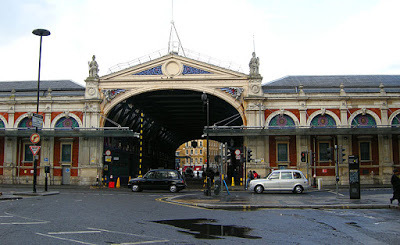 Smithfield Market in London
Smithfield Market in LondonFor me, as an avid student of English history, the Peasants’ Revolt of late spring/early summer of 1381, which began in Essex, was every bit as significant an event as the Magna Carta was in 1215, more than a century earlier.
Unlike those behind the Magna Carta, those revolting were poor folk, peasants who were still laboring under the harshness of serfdom and poor economic conditions. The Black Death had ended just 35 years before; the perennial war against the French was going badly, and, guess what, the poor were to have levied against them a Poll Tax.
Such behavior on the part of the French aristocrats was to turn out very badly for them centuries hence, but this was still only the 14th century…and it was England. Anger against the Poll Tax soon turned into demands that all men deserved more freedom, equal treatment under the law, and a more equitable distribution of wealth.
Kent joined with Essex and there began a march towards London, reaching the gates of the city on the 13th of June. The Kentish rebels were led by a man named Jack Straw; the Essex contingent was led by an ex-soldier named Wat (Walter) Tyler. The rebel army met with the 14-year-old King Richard II, but before demands were heard, the Lord Mayor of London, a William Walworth, attacked and killed Wat Tyler. The rebels were in disarray when the king stepped forth and made a promise to the peasants that he would abolish serfdom. Satisfied that a major demand had been met, the rebels returned home…only to meet death by hanging by the government soldiers who followed them, giving no quarter to anyone who’d participated in the revolt.
(Put not your faith in princes…ah, always so true!)
Another important individual associated with the rebellion was a Lollard preacher named John Ball, who had been imprisoned by the Archbishop of Canterbury and freed by the rebels. He was a staunch believer in the equality of all men and is famous for a sermon he preached that asked, “When Adam delved and Eve span, who was then the gentleman?” That quote lived on after his execution and still lives today.
What did the rebels gain? Well, no poll tax was collected for hundreds of years after and perhaps a good deal of fear was put into the mean hearts of the rich and of the church – which protected the rights of the rich – Tyler, Straw, and the murderer mayor Walworth, were immortalized and took their place in English history and mythology. The Lollards faced at least a hundred years of persecution owing to the part the priest John Ball played in the rebellion.
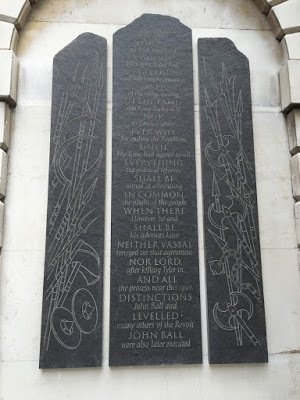 New plaque at Smithfield Market…
New plaque at Smithfield Market…Interpretations by historians of those who took part in this rebellion against royal authority have gone back and forth over the years. Were they the vicious mob portrayed by the aristocratic chroniclers? Or were they actually the first working-class heroes in England, fighting for the rights of all? It is estimated that about 60,000 rebels (and not all of them were necessarily peasants) took part in this revolt.
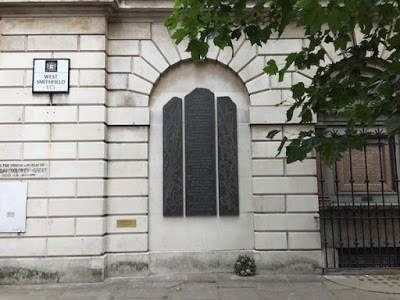 Another view of the plaque
Another view of the plaqueThe plaque at Smithfield Market, where the confrontation between the rebels and the king took place, is considered long overdue, and welcomed by many who would rather deem it the English Rising than the Peasants’ Revolt and trace the beginnings of democracy in England to this important event.
Published on August 03, 2015 00:30
July 31, 2015
THE WELLINGTON TOUR: ST. JAMES WALK
.
On Sunday, the tour group had several options. Kristine and Victoria led a walking tour of St. James's. Some others had different agendas. One went to Stratford on Avon for the day; some did a Harry Potter Tour, for example.
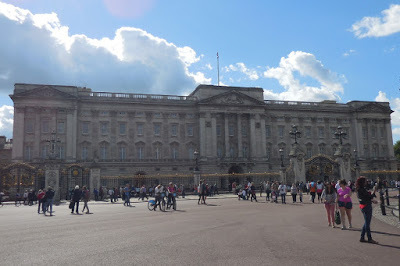
We walked from our hotel near Victoria Station past Buckingham Palace and the Victoria Monument, Being a Sunday, the traffic circle and the Mall were open for strollers and bicycles. Our weather was perfect, warm and sunny without being humid or sticky.
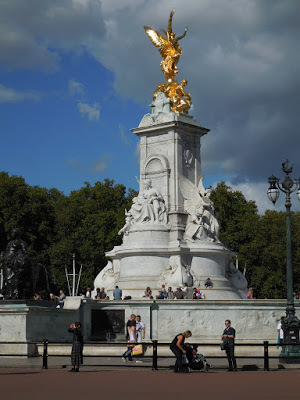
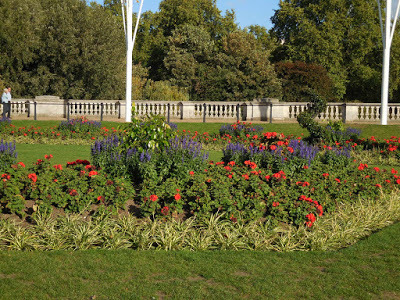 Flower Beds were gloriously abundant.
Flower Beds were gloriously abundant.
We headed up the path in Green Park past Lancaster House, Spencer House, and other posh residences.
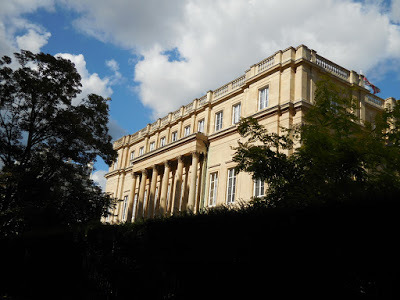 Lancaster House
Lancaster House
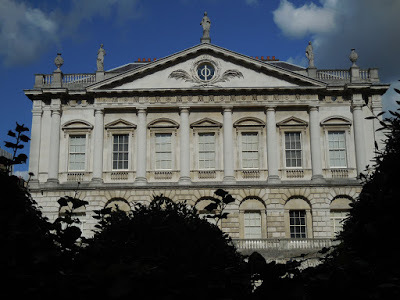 Spencer House, West Facade
Spencer House, West Facade
We cut through the narrow Milkmaids Passage which opens into a few short streets and cul-du-sacs of western St. James's.
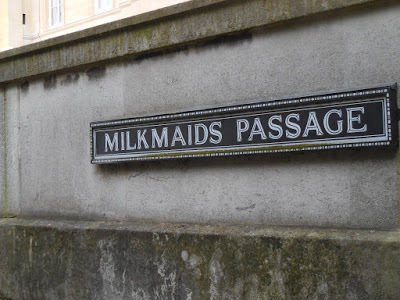
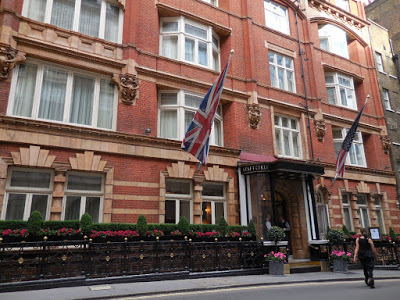 The Stafford Hotel (much remodeled) was once the home of Sir William, 3rd Baronet Lyttelton, and his wife (1787-1870), the former Lady Sarah Spencer, niece of Georgiana, Duchess of Devonshire. After her husband's death, Lady Lyttelton became a governess to the children of Queen Victoria and Prince Albert. The hotel;s fine restaurant is titled The Lyttelton. For more about the hotel, click here.
The Stafford Hotel (much remodeled) was once the home of Sir William, 3rd Baronet Lyttelton, and his wife (1787-1870), the former Lady Sarah Spencer, niece of Georgiana, Duchess of Devonshire. After her husband's death, Lady Lyttelton became a governess to the children of Queen Victoria and Prince Albert. The hotel;s fine restaurant is titled The Lyttelton. For more about the hotel, click here.
Wandering around the maze of streets in this little corner of St. James's, we found a mix of modern (often brutalist) office/apartment complexes and a few listed buildings fro the 18th century.
for example, those below:
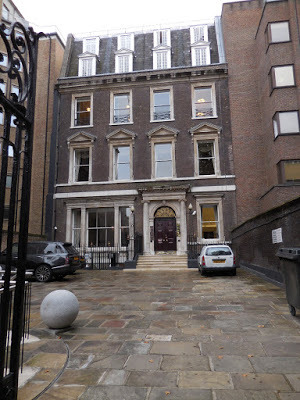 21 Arlington Street, built 1738-40 by Architect Giacomo Leoni for Richard Boyle, Earl of Burlington, an excellent example of Palladianism stripped down to its essentials (ig nore the aadded top floor)
21 Arlington Street, built 1738-40 by Architect Giacomo Leoni for Richard Boyle, Earl of Burlington, an excellent example of Palladianism stripped down to its essentials (ig nore the aadded top floor)
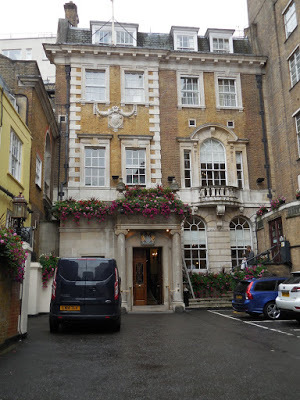 Royal Overseas Club, in Park Place
Royal Overseas Club, in Park Place
We followed the ins and outs of this maze to the entrane facade of Spencer House in St. James's Place.
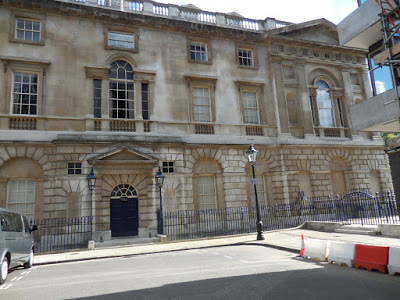 Spencer House, built 1756-66 by Architects John Vardy and James "Athenian" Stuart for John, 1st Earl Spencer. It is now owned by the Rothschild Enterprise's RIT Capital Partners and open on most Sundays for a tur of the State Rooms. The website is here and includes photos of both the exterior and interior.
Spencer House, built 1756-66 by Architects John Vardy and James "Athenian" Stuart for John, 1st Earl Spencer. It is now owned by the Rothschild Enterprise's RIT Capital Partners and open on most Sundays for a tur of the State Rooms. The website is here and includes photos of both the exterior and interior.
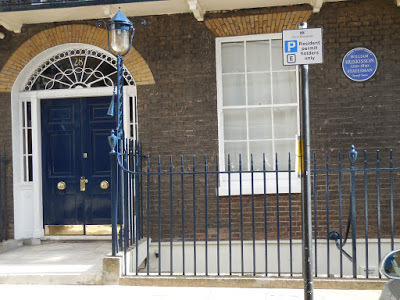 Nearby is a handsome brick house once the residence of Williams Huskisson (1770-1830). The blue plaque calls him a statesman; he was often a strong opponent politically in Parliament of the Duke of Wellington. He is also the first man to be killed in a railway accident when a demonstration run of the Rocket ran over him in the presence of many notables including the duke.
Nearby is a handsome brick house once the residence of Williams Huskisson (1770-1830). The blue plaque calls him a statesman; he was often a strong opponent politically in Parliament of the Duke of Wellington. He is also the first man to be killed in a railway accident when a demonstration run of the Rocket ran over him in the presence of many notables including the duke.
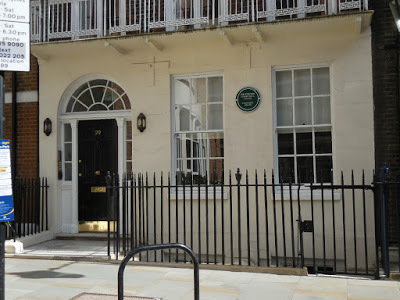 N. 29 was once the residence of Winston Churchill.
N. 29 was once the residence of Winston Churchill.
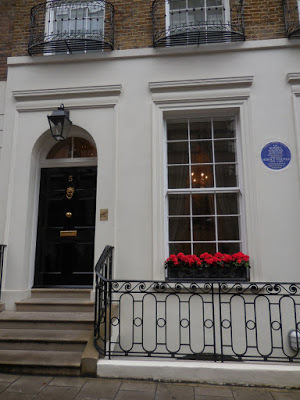 #5 was the home of Sir Robert Walpole (1676-1745) and his son Horace Walpole (1717-1797)
#5 was the home of Sir Robert Walpole (1676-1745) and his son Horace Walpole (1717-1797)
Another famous resident of St James Place, at #4, was composer and pianist Frederic Chopin (1810-49)
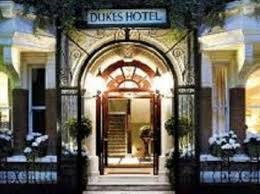 Duke's Hotel is another elegant institution on St. James Place
Duke's Hotel is another elegant institution on St. James Place
St. James's Place after several twists and turns, opens into St. James's Street, that famous location of St. James's Palace, gentlemen's clubs of the British variety, and several very old merchants. The numbering begins at the Palace and goes north up the east side of the street to Piccadilly then crosses to the west side and counts southward back to the Palace.
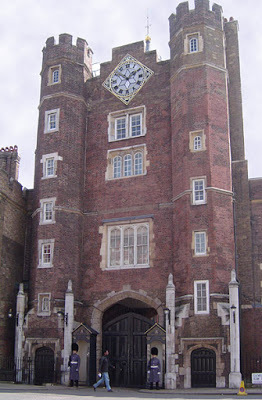 The Palace at the bottom of the street
The Palace at the bottom of the street
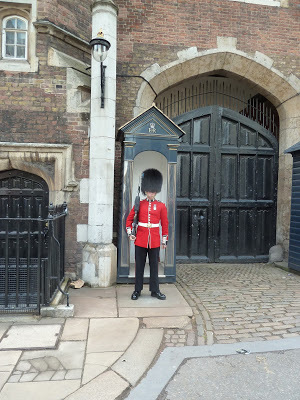 Grenadier Guard at St James's Palace, built by Henry VIII
Grenadier Guard at St James's Palace, built by Henry VIII
But feeling the need for a sit-don and some coffee, we retired to a cafe in Piccadilly before taking up our trou again.
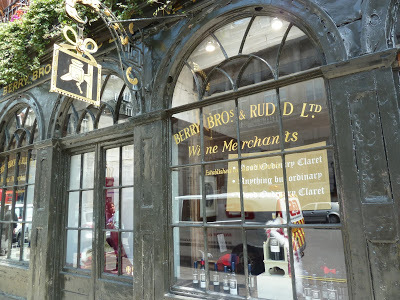 Berry Bros. and Rudd, Ltd, Wine Merchants, #3 St. James's StreetTheir website is here.
Berry Bros. and Rudd, Ltd, Wine Merchants, #3 St. James's StreetTheir website is here.
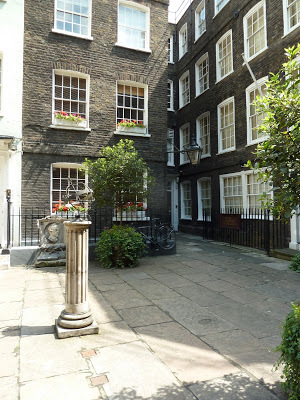 A Passage beside the wine store leads to Pickering Place, above and below.Tnhis little space was once known as a spot for dueling, but it must have been pretty tight!
A Passage beside the wine store leads to Pickering Place, above and below.Tnhis little space was once known as a spot for dueling, but it must have been pretty tight!
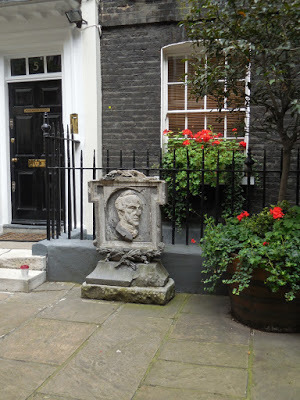 Pickering Place,with a plaque of Lord Palmerston
Pickering Place,with a plaque of Lord Palmerston
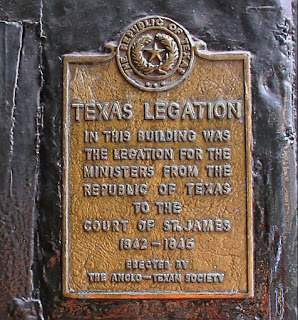 Another plaque commemorates the location of the Texas legation 1842-1846.Denise particularly was excited to find this. Winder why? A Texan, perhaps?
Another plaque commemorates the location of the Texas legation 1842-1846.Denise particularly was excited to find this. Winder why? A Texan, perhaps?
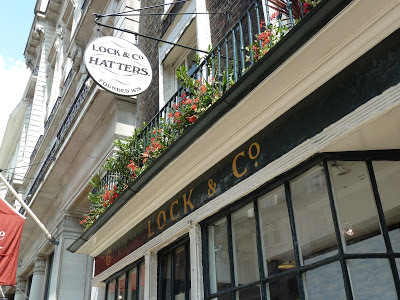 Lock and Co. Hatters have served british dignitaries for more than 300 years.Click here for their website..
Lock and Co. Hatters have served british dignitaries for more than 300 years.Click here for their website..
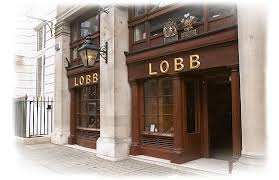 Lobb and Co. Bootmakers
Lobb and Co. Bootmakers
Closer to Piccadilly on the east side of the street are two famous Clubs
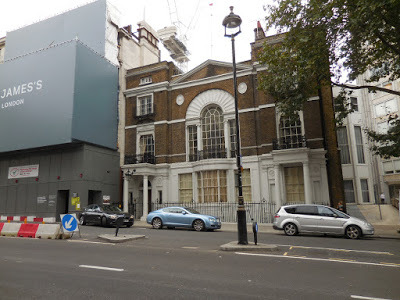 Boodle's, #27 St. James's Street
Boodle's, #27 St. James's Street
.
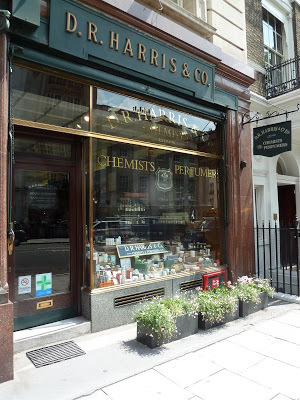 The chemist's shop, D. R. Harris, founded in 1790, is located at #29. The website is here.
The chemist's shop, D. R. Harris, founded in 1790, is located at #29. The website is here.
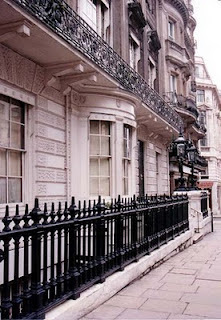 White's Club, #37/38 St. James's Street, founded 1693
White's Club, #37/38 St. James's Street, founded 1693
Om the west side, heading back to St. James's Palace, you will find Brook's Club.
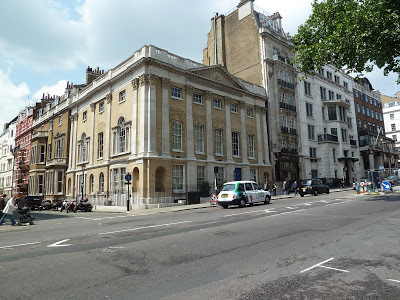 Brooks's 60 St. James's Street, club founded in 1762
Brooks's 60 St. James's Street, club founded in 1762
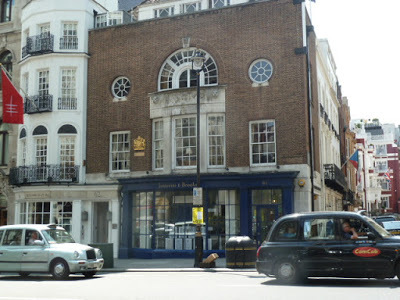 The headquarters of Justerini and Brooks Ltd. at 61 St. James Stacross Park Place from Brooks's.
The headquarters of Justerini and Brooks Ltd. at 61 St. James Stacross Park Place from Brooks's.
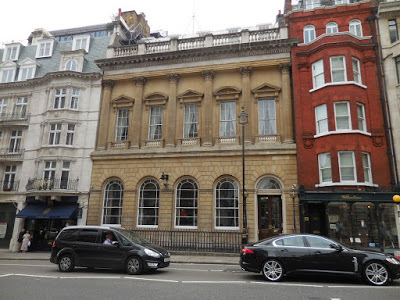 The Carlton Club, #69 St. James's Street, founded in 1832
The Carlton Club, #69 St. James's Street, founded in 1832
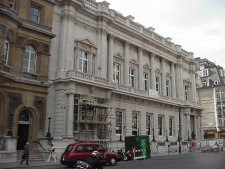 #74 St. James's Street, formerly the Conservative Club, completed in 1845
#74 St. James's Street, formerly the Conservative Club, completed in 1845
Returning to Piccadilly, we stopped for a welcome sit-down and a coffee or tea. Even on a Sunday morning, Piccadilly was busy, as usual an international mish-mash of tourists globe-wide. Great people watching!
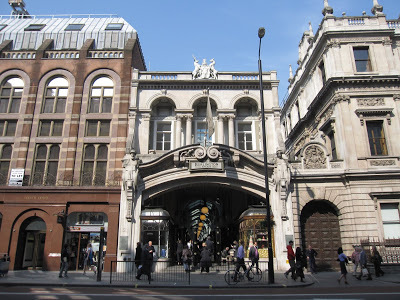 Burlington Arcade
Burlington Arcade
We walked east on Piccadilly past a number of famous sites: on the north side of the street, Burlington Arcade.
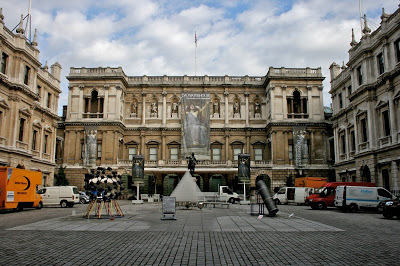 And Burlington House, home of the Royal Academy of Arts.
And Burlington House, home of the Royal Academy of Arts.
Tucked almost beside Burlington House is the famous residence, Albany, once the home of Lord Byron and more recently, Georgette Heyer. Built originally as Melbourne House. it was traded by that family to the Duke of York and Albany (2nd son of George III) in exchange for what became Melbourne House in Whitehall, now the Scotland office just south of Horse Guards. Later it became prestigious bachelor quarters, eventually open to women as well.
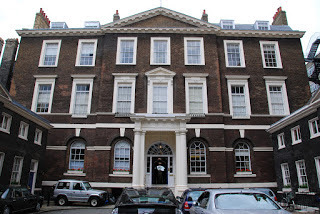 Albany
Albany
On the South side of the street, that esteemed purveyor of all things delicious, Fortnum and Mason, established in 1707 in Duke Street, and supplier worldwide, including to the army in the Peninsular War in the early 19th century, right up to today's British forces -- not to mention picnickers, racegoers, opera lovers, and foodies everywhere., To visit, click here..
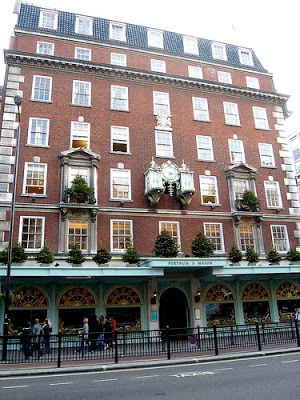 Fortnum and Mason
Fortnum and Mason
Hatchards
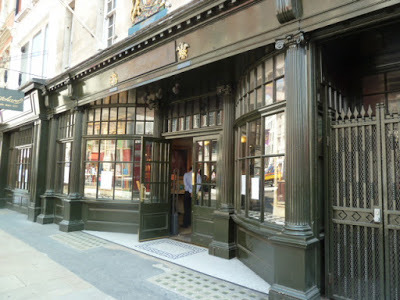 Hatchards
Hatchards
Hatchards Bookstore, established 1797 Their website is here.
Soon, we arrive at the wonderful St James's Church, Piccadilly.
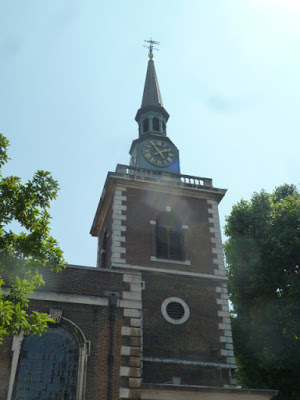
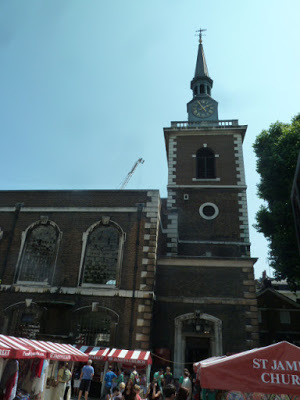 Outside the church is a small but lively marketplace
Outside the church is a small but lively marketplace
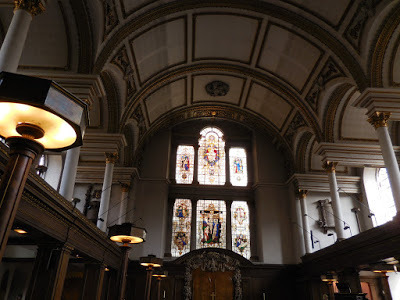
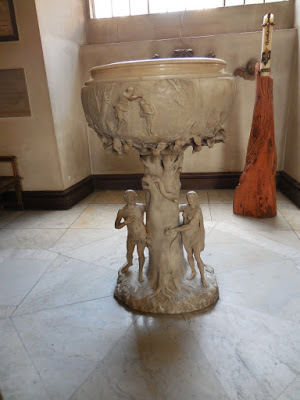 Baptismal font
Baptismal font
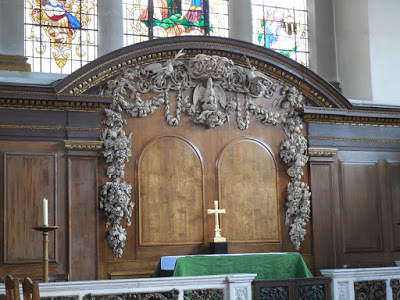 The famous wood carvings of Grinling Gibbons
The famous wood carvings of Grinling Gibbons
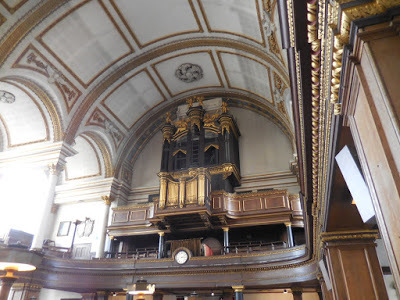 Organ loft at the rear of the church
Organ loft at the rear of the church
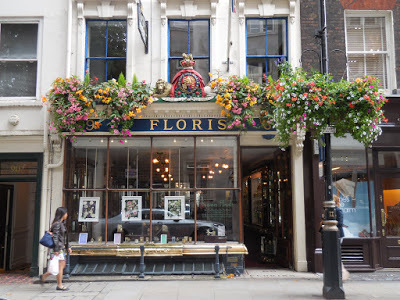 Floris Perfumers on Jermyn Street
Floris Perfumers on Jermyn Street
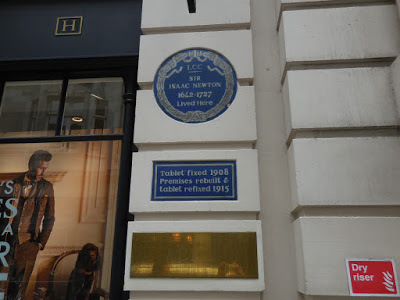 Nearby, a plaque marking the location of the residence of Sir Isaac Newton (1642-1727)
Nearby, a plaque marking the location of the residence of Sir Isaac Newton (1642-1727)
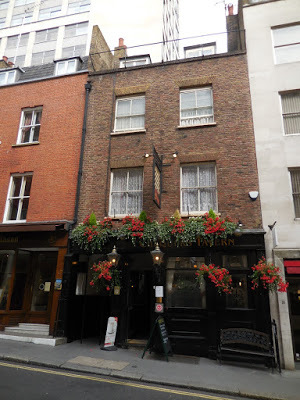 Chequers Pub
Chequers Pub
Time for another pause that refreshes, this time at Chequers...a charming little pub in Duke street. At the read of the building or accessible from a passage beside it is Mason's Yard, another hidden collection of interesting sites, including the White Cube Gallery and the member's entrance of the London Library.
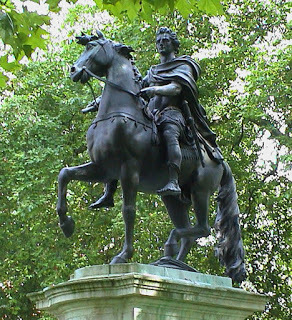 William III in St. James's Square
William III in St. James's Square
At last we came to St. James;s Square, still a leafy oasis, though a private park as so man of the squares in London are.
There aer still a few of the buildings originally built here, though much remodeled, and many replaced. At #4 is the Naval and Military Club, better known as the In and Out Club.
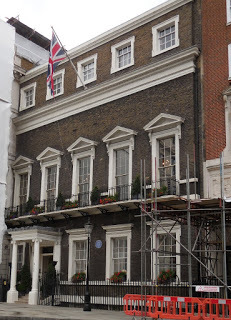 #4 St. James's Square
#4 St. James's Square
The plaque honors Nancy Astor (1879-1964), first woman to sit in Parliament, who once lived here.
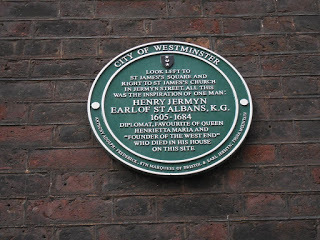 Henry Jermyn, 1st Earl of St. Albans, 1605-1684
Henry Jermyn, 1st Earl of St. Albans, 1605-1684
Following the Restoration of King Charles II in 1660, Henry Jermyn was Lord Chancellor, and received a grant of land north of St. James's Palace, which he had cleared and laid out for development. He is known as the Father of the West End. He died shortly before the completion of St. James's Church, just north of St. James Square.
At #10 St. James's Square stands Chatham House, the Royal Institute of International Affairs, site of many important multilateral events. The building was once home to three Prime Ministers, William Pitt, 1st Earl of Chatham (1708-1778), Edward Geoffrey Stanley, Earl of Derby (1799-1869), and William Ewart Gladstone (1809-1898).
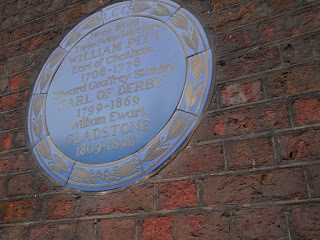 Plaque honoring three Prime Ministers at #10 St. James's Square
Plaque honoring three Prime Ministers at #10 St. James's Square
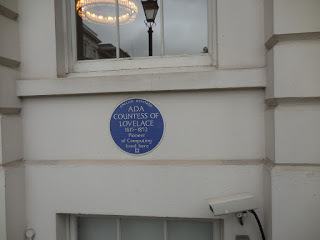 Ada, Countess of Lovelace(1815-52) at #12 St James's Square
Ada, Countess of Lovelace(1815-52) at #12 St James's Square
Ada Lovelace was the only legitimate child of Lord Byron and his wife, Anabella Millbanke. She was a mathematician and a pioneer in computing.
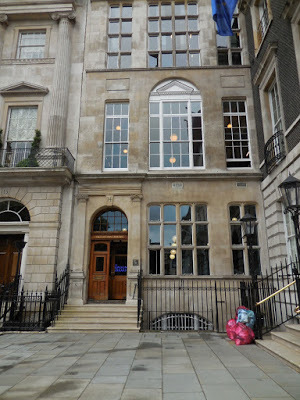 London Library, #14 St. James's Square
London Library, #14 St. James's Square
The private library, established in 1841, is a favorite of many British writers and historians. Kristine and victoria returned here the week after the tour for a special viewing during London Open House Week. Watch for our report in a few weeks.
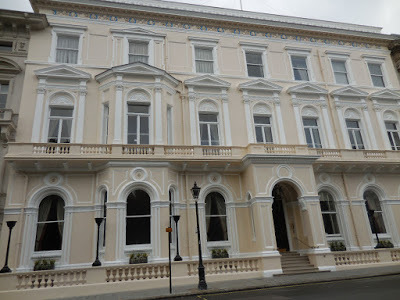 #16 St. James's Square, once the Boehm residence where the Prince Regent received the despatches of the Duke of Wellington after the Battle of Waterloo,now the East India Services Club
#16 St. James's Square, once the Boehm residence where the Prince Regent received the despatches of the Duke of Wellington after the Battle of Waterloo,now the East India Services Club
By this time we were all ready for our tea, so we hiked back to Piccadilly and the wonderful Richoux Tea Room at #172.
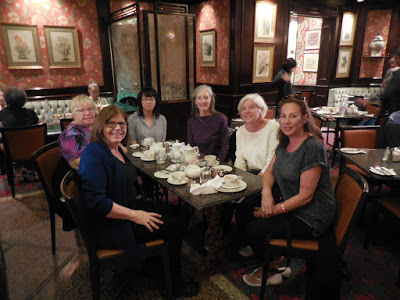 The Survivors l to r: Victoria, Diane, Ki, Donna, Marilyn, Kristine
The Survivors l to r: Victoria, Diane, Ki, Donna, Marilyn, Kristine
NEXT ON FRIEDAY: THE DUKE OF WELLINGTON TOUR STORMS WALMER CASTLE
On Sunday, the tour group had several options. Kristine and Victoria led a walking tour of St. James's. Some others had different agendas. One went to Stratford on Avon for the day; some did a Harry Potter Tour, for example.

We walked from our hotel near Victoria Station past Buckingham Palace and the Victoria Monument, Being a Sunday, the traffic circle and the Mall were open for strollers and bicycles. Our weather was perfect, warm and sunny without being humid or sticky.

 Flower Beds were gloriously abundant.
Flower Beds were gloriously abundant.We headed up the path in Green Park past Lancaster House, Spencer House, and other posh residences.
 Lancaster House
Lancaster House Spencer House, West Facade
Spencer House, West FacadeWe cut through the narrow Milkmaids Passage which opens into a few short streets and cul-du-sacs of western St. James's.

 The Stafford Hotel (much remodeled) was once the home of Sir William, 3rd Baronet Lyttelton, and his wife (1787-1870), the former Lady Sarah Spencer, niece of Georgiana, Duchess of Devonshire. After her husband's death, Lady Lyttelton became a governess to the children of Queen Victoria and Prince Albert. The hotel;s fine restaurant is titled The Lyttelton. For more about the hotel, click here.
The Stafford Hotel (much remodeled) was once the home of Sir William, 3rd Baronet Lyttelton, and his wife (1787-1870), the former Lady Sarah Spencer, niece of Georgiana, Duchess of Devonshire. After her husband's death, Lady Lyttelton became a governess to the children of Queen Victoria and Prince Albert. The hotel;s fine restaurant is titled The Lyttelton. For more about the hotel, click here.Wandering around the maze of streets in this little corner of St. James's, we found a mix of modern (often brutalist) office/apartment complexes and a few listed buildings fro the 18th century.
for example, those below:
 21 Arlington Street, built 1738-40 by Architect Giacomo Leoni for Richard Boyle, Earl of Burlington, an excellent example of Palladianism stripped down to its essentials (ig nore the aadded top floor)
21 Arlington Street, built 1738-40 by Architect Giacomo Leoni for Richard Boyle, Earl of Burlington, an excellent example of Palladianism stripped down to its essentials (ig nore the aadded top floor) Royal Overseas Club, in Park Place
Royal Overseas Club, in Park PlaceWe followed the ins and outs of this maze to the entrane facade of Spencer House in St. James's Place.
 Spencer House, built 1756-66 by Architects John Vardy and James "Athenian" Stuart for John, 1st Earl Spencer. It is now owned by the Rothschild Enterprise's RIT Capital Partners and open on most Sundays for a tur of the State Rooms. The website is here and includes photos of both the exterior and interior.
Spencer House, built 1756-66 by Architects John Vardy and James "Athenian" Stuart for John, 1st Earl Spencer. It is now owned by the Rothschild Enterprise's RIT Capital Partners and open on most Sundays for a tur of the State Rooms. The website is here and includes photos of both the exterior and interior. Nearby is a handsome brick house once the residence of Williams Huskisson (1770-1830). The blue plaque calls him a statesman; he was often a strong opponent politically in Parliament of the Duke of Wellington. He is also the first man to be killed in a railway accident when a demonstration run of the Rocket ran over him in the presence of many notables including the duke.
Nearby is a handsome brick house once the residence of Williams Huskisson (1770-1830). The blue plaque calls him a statesman; he was often a strong opponent politically in Parliament of the Duke of Wellington. He is also the first man to be killed in a railway accident when a demonstration run of the Rocket ran over him in the presence of many notables including the duke.  N. 29 was once the residence of Winston Churchill.
N. 29 was once the residence of Winston Churchill. #5 was the home of Sir Robert Walpole (1676-1745) and his son Horace Walpole (1717-1797)
#5 was the home of Sir Robert Walpole (1676-1745) and his son Horace Walpole (1717-1797)Another famous resident of St James Place, at #4, was composer and pianist Frederic Chopin (1810-49)
 Duke's Hotel is another elegant institution on St. James Place
Duke's Hotel is another elegant institution on St. James PlaceSt. James's Place after several twists and turns, opens into St. James's Street, that famous location of St. James's Palace, gentlemen's clubs of the British variety, and several very old merchants. The numbering begins at the Palace and goes north up the east side of the street to Piccadilly then crosses to the west side and counts southward back to the Palace.
 The Palace at the bottom of the street
The Palace at the bottom of the street Grenadier Guard at St James's Palace, built by Henry VIII
Grenadier Guard at St James's Palace, built by Henry VIIIBut feeling the need for a sit-don and some coffee, we retired to a cafe in Piccadilly before taking up our trou again.
 Berry Bros. and Rudd, Ltd, Wine Merchants, #3 St. James's StreetTheir website is here.
Berry Bros. and Rudd, Ltd, Wine Merchants, #3 St. James's StreetTheir website is here. A Passage beside the wine store leads to Pickering Place, above and below.Tnhis little space was once known as a spot for dueling, but it must have been pretty tight!
A Passage beside the wine store leads to Pickering Place, above and below.Tnhis little space was once known as a spot for dueling, but it must have been pretty tight! Pickering Place,with a plaque of Lord Palmerston
Pickering Place,with a plaque of Lord Palmerston Another plaque commemorates the location of the Texas legation 1842-1846.Denise particularly was excited to find this. Winder why? A Texan, perhaps?
Another plaque commemorates the location of the Texas legation 1842-1846.Denise particularly was excited to find this. Winder why? A Texan, perhaps? Lock and Co. Hatters have served british dignitaries for more than 300 years.Click here for their website..
Lock and Co. Hatters have served british dignitaries for more than 300 years.Click here for their website.. Lobb and Co. Bootmakers
Lobb and Co. BootmakersCloser to Piccadilly on the east side of the street are two famous Clubs
 Boodle's, #27 St. James's Street
Boodle's, #27 St. James's Street.
 The chemist's shop, D. R. Harris, founded in 1790, is located at #29. The website is here.
The chemist's shop, D. R. Harris, founded in 1790, is located at #29. The website is here. White's Club, #37/38 St. James's Street, founded 1693
White's Club, #37/38 St. James's Street, founded 1693Om the west side, heading back to St. James's Palace, you will find Brook's Club.
 Brooks's 60 St. James's Street, club founded in 1762
Brooks's 60 St. James's Street, club founded in 1762 The headquarters of Justerini and Brooks Ltd. at 61 St. James Stacross Park Place from Brooks's.
The headquarters of Justerini and Brooks Ltd. at 61 St. James Stacross Park Place from Brooks's. The Carlton Club, #69 St. James's Street, founded in 1832
The Carlton Club, #69 St. James's Street, founded in 1832  #74 St. James's Street, formerly the Conservative Club, completed in 1845
#74 St. James's Street, formerly the Conservative Club, completed in 1845Returning to Piccadilly, we stopped for a welcome sit-down and a coffee or tea. Even on a Sunday morning, Piccadilly was busy, as usual an international mish-mash of tourists globe-wide. Great people watching!
 Burlington Arcade
Burlington ArcadeWe walked east on Piccadilly past a number of famous sites: on the north side of the street, Burlington Arcade.
 And Burlington House, home of the Royal Academy of Arts.
And Burlington House, home of the Royal Academy of Arts.Tucked almost beside Burlington House is the famous residence, Albany, once the home of Lord Byron and more recently, Georgette Heyer. Built originally as Melbourne House. it was traded by that family to the Duke of York and Albany (2nd son of George III) in exchange for what became Melbourne House in Whitehall, now the Scotland office just south of Horse Guards. Later it became prestigious bachelor quarters, eventually open to women as well.
 Albany
AlbanyOn the South side of the street, that esteemed purveyor of all things delicious, Fortnum and Mason, established in 1707 in Duke Street, and supplier worldwide, including to the army in the Peninsular War in the early 19th century, right up to today's British forces -- not to mention picnickers, racegoers, opera lovers, and foodies everywhere., To visit, click here..
 Fortnum and Mason
Fortnum and MasonHatchards
 Hatchards
HatchardsHatchards Bookstore, established 1797 Their website is here.
Soon, we arrive at the wonderful St James's Church, Piccadilly.

 Outside the church is a small but lively marketplace
Outside the church is a small but lively marketplace
 Baptismal font
Baptismal font The famous wood carvings of Grinling Gibbons
The famous wood carvings of Grinling Gibbons  Organ loft at the rear of the church
Organ loft at the rear of the church Floris Perfumers on Jermyn Street
Floris Perfumers on Jermyn Street Nearby, a plaque marking the location of the residence of Sir Isaac Newton (1642-1727)
Nearby, a plaque marking the location of the residence of Sir Isaac Newton (1642-1727) Chequers Pub
Chequers PubTime for another pause that refreshes, this time at Chequers...a charming little pub in Duke street. At the read of the building or accessible from a passage beside it is Mason's Yard, another hidden collection of interesting sites, including the White Cube Gallery and the member's entrance of the London Library.
 William III in St. James's Square
William III in St. James's SquareAt last we came to St. James;s Square, still a leafy oasis, though a private park as so man of the squares in London are.
There aer still a few of the buildings originally built here, though much remodeled, and many replaced. At #4 is the Naval and Military Club, better known as the In and Out Club.
 #4 St. James's Square
#4 St. James's SquareThe plaque honors Nancy Astor (1879-1964), first woman to sit in Parliament, who once lived here.
 Henry Jermyn, 1st Earl of St. Albans, 1605-1684
Henry Jermyn, 1st Earl of St. Albans, 1605-1684Following the Restoration of King Charles II in 1660, Henry Jermyn was Lord Chancellor, and received a grant of land north of St. James's Palace, which he had cleared and laid out for development. He is known as the Father of the West End. He died shortly before the completion of St. James's Church, just north of St. James Square.
At #10 St. James's Square stands Chatham House, the Royal Institute of International Affairs, site of many important multilateral events. The building was once home to three Prime Ministers, William Pitt, 1st Earl of Chatham (1708-1778), Edward Geoffrey Stanley, Earl of Derby (1799-1869), and William Ewart Gladstone (1809-1898).
 Plaque honoring three Prime Ministers at #10 St. James's Square
Plaque honoring three Prime Ministers at #10 St. James's Square Ada, Countess of Lovelace(1815-52) at #12 St James's Square
Ada, Countess of Lovelace(1815-52) at #12 St James's SquareAda Lovelace was the only legitimate child of Lord Byron and his wife, Anabella Millbanke. She was a mathematician and a pioneer in computing.
 London Library, #14 St. James's Square
London Library, #14 St. James's SquareThe private library, established in 1841, is a favorite of many British writers and historians. Kristine and victoria returned here the week after the tour for a special viewing during London Open House Week. Watch for our report in a few weeks.
 #16 St. James's Square, once the Boehm residence where the Prince Regent received the despatches of the Duke of Wellington after the Battle of Waterloo,now the East India Services Club
#16 St. James's Square, once the Boehm residence where the Prince Regent received the despatches of the Duke of Wellington after the Battle of Waterloo,now the East India Services Club By this time we were all ready for our tea, so we hiked back to Piccadilly and the wonderful Richoux Tea Room at #172.
 The Survivors l to r: Victoria, Diane, Ki, Donna, Marilyn, Kristine
The Survivors l to r: Victoria, Diane, Ki, Donna, Marilyn, KristineNEXT ON FRIEDAY: THE DUKE OF WELLINGTON TOUR STORMS WALMER CASTLE
Published on July 31, 2015 00:30
July 29, 2015
WATERLOO: IN THE NATION OF BELGIUM TODAY
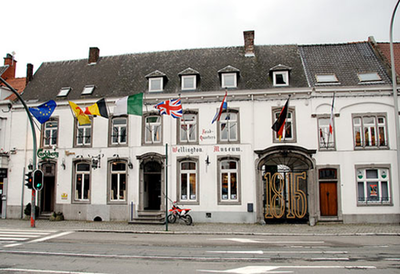 Wellington's Headquarters, Waterloo
Wellington's Headquarters, WaterlooGallica Belgica was the name of a Roman province in northern Gaul. The region often called “the low countries” has been the scene of many wars, involving the French, the Habsburgs, the Austrians, the Spanish, and various Germanic peoples. Cities in the region were important trading partners of Britain across the North Sea.
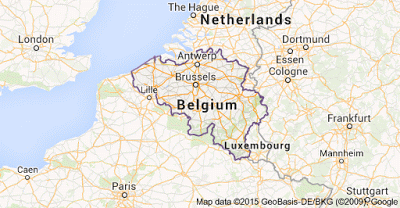 Today's Belgium
Today's BelgiumUnder Napoleon, France absorbed parts of the low countries, which were brought together as the United Kingdom of the Netherlands in 1815 in a settlement agreed at the Congress of Vienna but carried out in effect by the man who became King William I of the United Kingdom of the Netherlands, a prince of the House of Orange-Nassau.
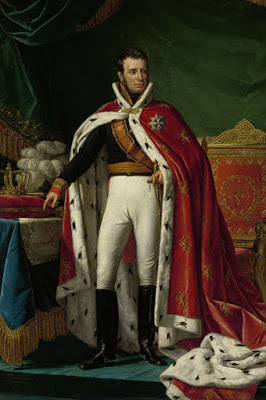 King William I of the Netherlands in Coronation Robes by Josephy Paelinck
King William I of the Netherlands in Coronation Robes by Josephy Paelinck In 1815, King William insisted that his son, the young William, Prince of Orange, be given a leading role in the upcoming battles against Napoleon. The Duke of Wellington and his staff thought little of the military experience and capabilities of Slender Billy (who incidentally had been a suitor of Princess Charlotte of Wales -- for more about her, see below). The unfortunate Prince was wounded in the battle; the Lion Mound, constructed 1820-26 at the site of the battle, is a memorial to him.
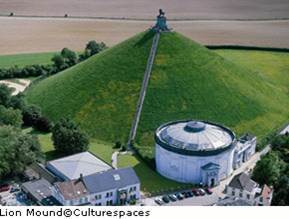 The Lion Mound, over 140 feet high also showing the Panorama and other buildings
The Lion Mound, over 140 feet high also showing the Panorama and other buildingsThe Prince of Orange went on to be King William II of the Netherlands from 1840 to his death in 1849. The southern provinces had revolted and set up the Bellgian government in 1830-31. Shortly before William II died, Holland became a constitutional monarchy, which is the form of its government today.
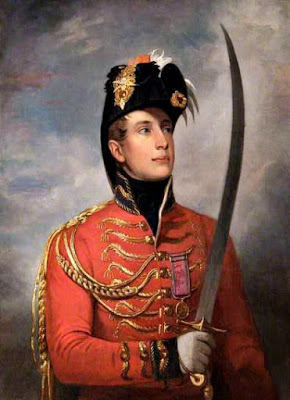 William, Hereditary Prince of Orange, later William II 1792-1849
William, Hereditary Prince of Orange, later William II 1792-1849In 1830-31 the southern areas of the Kingdom of the Netherlands gained independence and set up the independent nation of Belgium as a constitutional monarchy. Chosen as first King of Belgium was Leopold I, formerly Prince of Saxe-Coburg, husband of the late Princess Charlotte of Wales
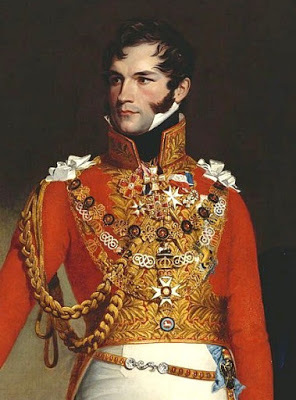 Leopold of Saxe-Coburg-Gotha, King of Belgium, crowned 1831
Leopold of Saxe-Coburg-Gotha, King of Belgium, crowned 1831Princess Charlotte of Wales (1796-1817),was the daughter of the Prince Regent and his wife Caroline of Brunswick, Princess of Wales (1796-1821). The current Belgian royal family descends from Leopold and his second wife, Louise of Orleans (1812-1850), but Leopold retained important influence over British affairs.
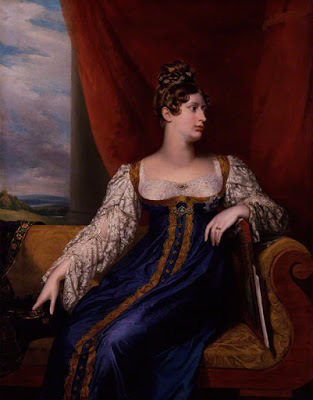 Princess Charlotte
Princess CharlotteIn 1815, Princess Charlotte of Wales (1796-1817) was the only legitimate grandchild of George III. Her father was the Prince of Wales, later Prince Regent and George IV after 1820. Charlotte had a difficult childhood. She became a pawn in the battles between the Prince and his wife, Caroline of Brunswick. The marriage was extremely unhappy to say the least. Charlotte eventually found a brief window of happiness when she married Leopold of Saxe Coburg Saalfeld. in May, 1816. Sadly the young princess died in November 1817, after delivering a stillborn son, The national mourning that followed is said to have been matched only by that after the death of Princess Diana in 1997.
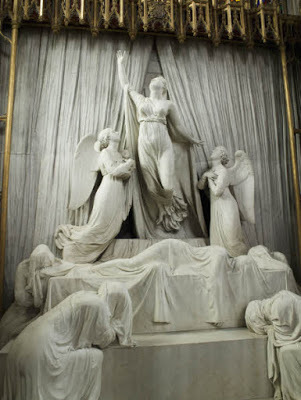 Memorial to Princess Charlotte of Wales, St. George's Chapel, Windsor Castle
Memorial to Princess Charlotte of Wales, St. George's Chapel, Windsor CastleThe grieving widower, Leopold, remained in Britain and participated in some political and governmental circles. For one thing, he advocated the marriage of his sister, Princess Victoire of Saxe Coburg Saalfeld to Prince Edward, Duke of Kent. Kent was one of several of the Prince Regent's brothers who looked for a wife to provide another heir to the throne. Victoire was a widow herself, with two healthy children, thus a proven breeder; Edward and Victoria married in 1818.The Princess Victoria was born to the couple on May 24, 1819. Just a few months later, the Duke died in January, 1820. Thus Leopold was an important advisor to his sister and his niece, the future Queen.
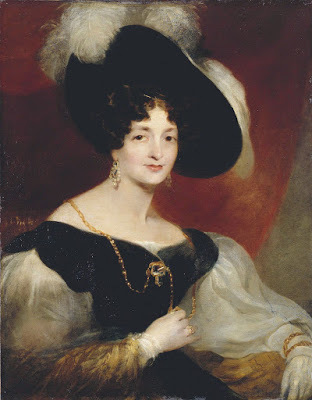 Victoire, Duchess of Kent
Victoire, Duchess of KentAfter Victoria became Queen of Great Britain in 1837, Leopold advised her mostly from afar, and promoted the suit of his nephew, Prince Albert of Saxe-Coburg, who married the Queen in 1840 and fathered her nine children.
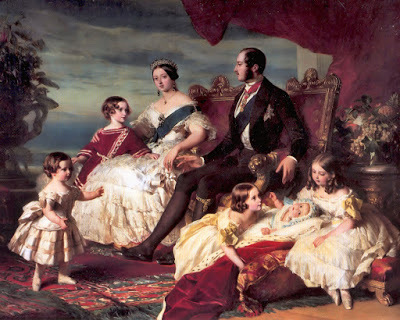 Victoria and her family 1846 by Franz Xavier Winterhalter
Victoria and her family 1846 by Franz Xavier Winterhalter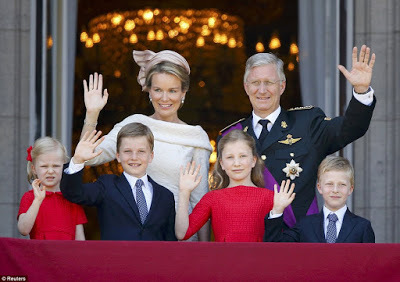 The Royal Family of Belgium in 20013
The Royal Family of Belgium in 20013The town of Waterloo is a few miles south of the capital of Brussels, something now of a commuter bedroom community. The Duke of Wellington had investigated the ground south of Waterloo, near the farm of Mont St. Jean, and chose it as the site where he would stand and repel the attacking French armies of Napoleon. Wellington spent the night before the battle in the village inn, now the Wellington Museum.
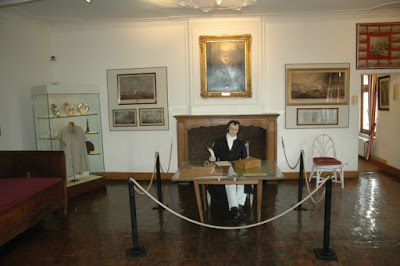
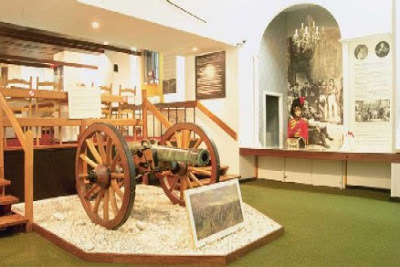
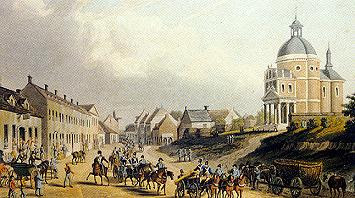 Waterloo 1815 - French guns being taken back to Brussels after the battle, Wellington's HQ on the left opposite St Joseph's church.
Waterloo 1815 - French guns being taken back to Brussels after the battle, Wellington's HQ on the left opposite St Joseph's church.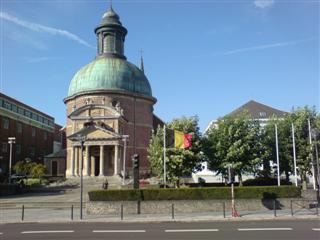 St. Joseph's church, Waterloo, completed in 1690
St. Joseph's church, Waterloo, completed in 1690The battle ground was a mile or so south of Waterloo, near the farm of Mont St. Jean.
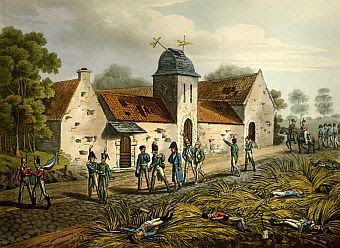
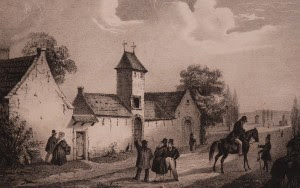 A contemporary image of Mont St. Jean
A contemporary image of Mont St. JeanThe battlefield started as farmland, high with crops of rye and wheat, much as it is today. Heavy rains of the night before had inundated the area, making a sea of mud into which the crops were trampled by guns, horses, and men's feet.
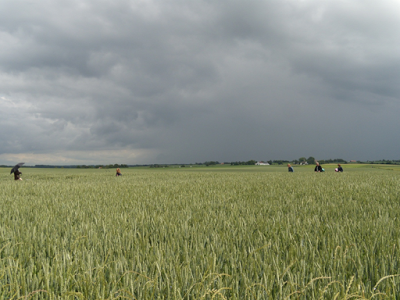
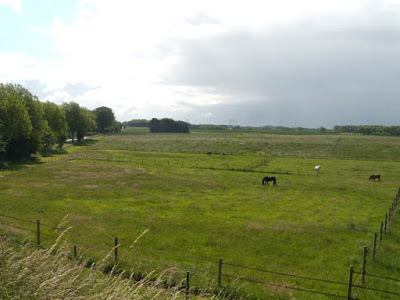 Above, the battleground as it appeared when we visited in 2010.
Above, the battleground as it appeared when we visited in 2010.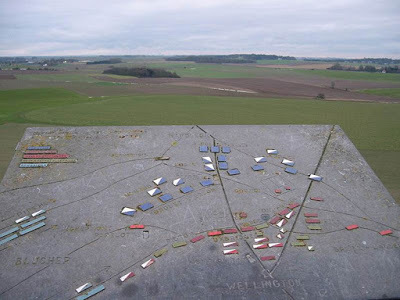 Near the Lion Mound is a diagram of the positions of the armies in 1815
Near the Lion Mound is a diagram of the positions of the armies in 1815Two farms occupied the ground between the slight Ridge at Mont St. Jean and the opposing ridge before which Napoleon arrayed his troops on the morning of June 18, 1815. The smaller farm was La Haye Sainte, the largest Chateau Hougoumont. Both are still there.
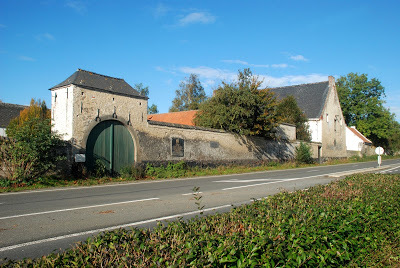 La Haye Sainte as it appears today
La Haye Sainte as it appears today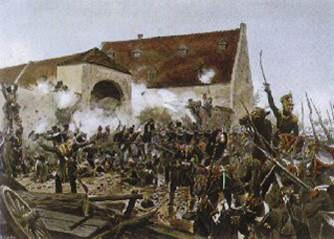 The Storming of La Haye Sainte by Richard Knotel
The Storming of La Haye Sainte by Richard KnotelLa Haye Sainte was defended by the King's German Legion who abandoned it to the French only after their ammunition ran out late in the day; of the original 400+ soldiers defending the farm, only about forty survived. La Haye Sainte was re-taken by the Allies late in the day as part of the final rout of the French troops.
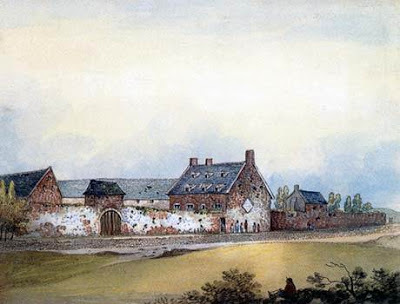 La Haye Sainte after the Battle
La Haye Sainte after the Battle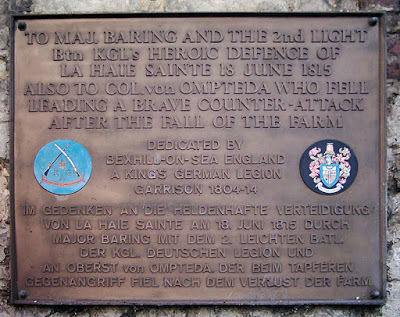 Memorial to the defenders of La Haye Saint, on the outer walls of the farm
Memorial to the defenders of La Haye Saint, on the outer walls of the farm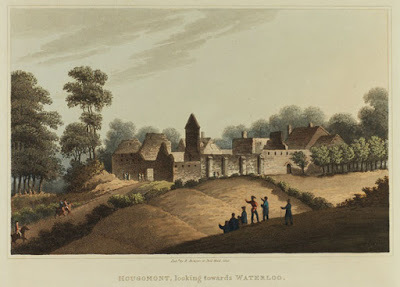 Chateau Hougoumont, after the battle in 1815
Chateau Hougoumont, after the battle in 1815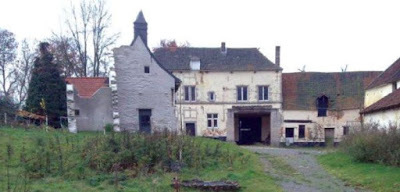 Chateau Hougoumont today, Left, the chapel, center the gardener's house
Chateau Hougoumont today, Left, the chapel, center the gardener's house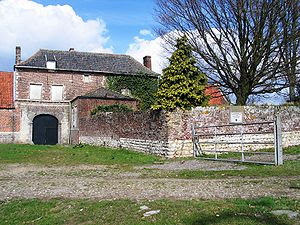 Another view of Chateau Hougoumont
Another view of Chateau Hougoumont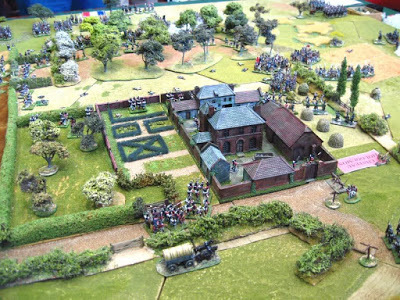 A model of Chateau Hougoumont as it might have appeared at the beginning of the battle
A model of Chateau Hougoumont as it might have appeared at the beginning of the battleThe chateau is still a working farm today, but the buildings were never restored after the battle and until recently simply deteriorated. In the past few years, considerable renovations have been funded. Hougoumont was considered by the Duke of Wellington to be the key point of his defensive battle. If it had fallen, he said, he thought the battle would have been lost.
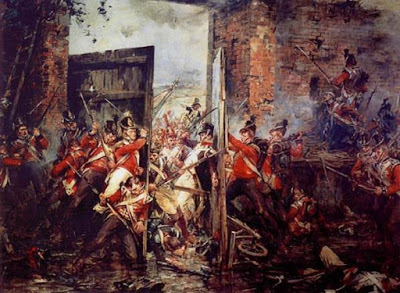 Closing the Gate
Closing the GateFierce battles raged all day around Hougoumont as the French sent wave after wave of troops to storm its thick walls. At one point they managed to get through the gates, but the British troops closed the gates and killed all the French caught inside with the exception of a young drummer boy, who was spared.
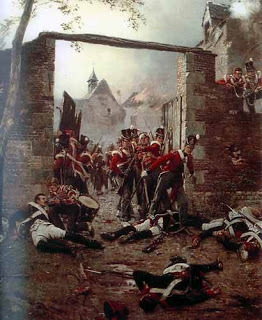 After the Battle
After the Battle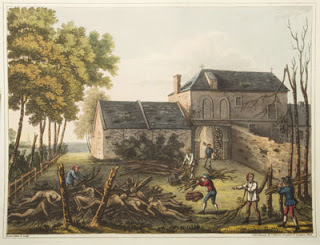 Print Burying the Dead by William Mudford, 1817
Print Burying the Dead by William Mudford, 1817For an excellent collection of prints and documents related to Waterloo, visit the Wrexham Heritage site, here.
One building that survived with relatively minor damage was the tiny chapel. A fire inside singed the feet of the wooden crucifix that hung there, but it stayed form many years until stolen in 2011. Fortunately it was recovered and is there today.
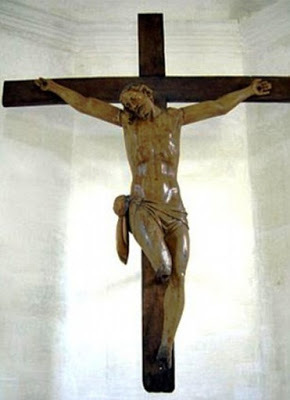
Today, many repairs have been made and the buildings will be further restored. For more information on Project Hougoumont, click here.
During the ceremonies that marked the 2015 Bicentenary of the battle, a new monument to British troops was unveiled at Hougoumont, representing the defenders who so crucially closed that gate.
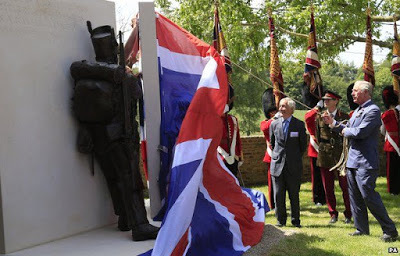 Prince Charles unveils the memorial, picture from the BBC
Prince Charles unveils the memorial, picture from the BBC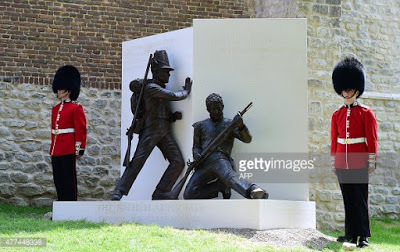 image copyright Getty Images
image copyright Getty ImagesThe pictures below were taken on the visit to the Battle of Waterloo site in 2010 made by Kristine and Victoria for the 195th anniversary. It is easy to see why the chateau was chosen as a key strategic location to protect. Its thick brick walls were impossible for the French troops to breach as the Allied troops mounted their vigorous defense.
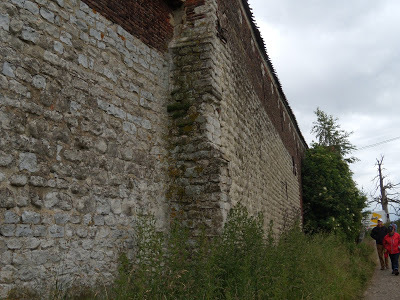
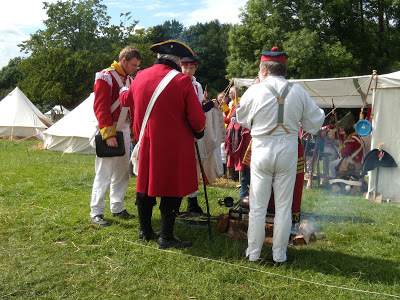 The encampment of the re-enactors of the British forces
The encampment of the re-enactors of the British forces 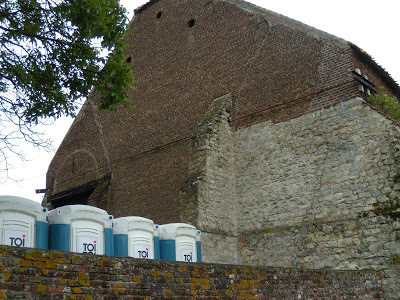 The British troop reenactors camped on the grounds of Hougoumont, and other than the above mod cons, lived as the defenders did in 1815.
The British troop reenactors camped on the grounds of Hougoumont, and other than the above mod cons, lived as the defenders did in 1815.The Waterloo battlefield and the nearby locations of the Battles of Quatre Bras and Ligny (Fleurus) are easy to visit as long as you have transportation as the distances are much too far to hike. Memorials are dotted here and there where battles were fought and won -- or lost. Personally I recommend hiring a knowledgeable guide who can explain the sequence of events and show off the relevant sites, museums, and memorials.
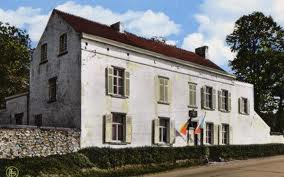 The Old farmhouse at Caillou, where Napoleon spent the night before the Battle of Waterloo.
The Old farmhouse at Caillou, where Napoleon spent the night before the Battle of Waterloo.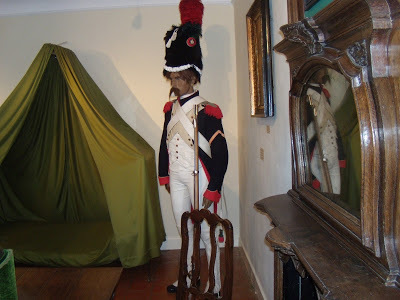 Inside Caillou is a replica of Napoleon's bed and other remembrances
Inside Caillou is a replica of Napoleon's bed and other remembrances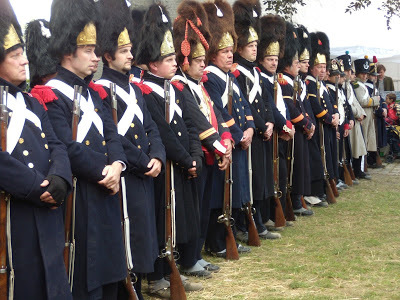 In 2010, the French re-enactors camped at Caillou
In 2010, the French re-enactors camped at CaillouIf you can travel to Waterloo and visit the other fascinations of Belgium, we highly recommend it!
Published on July 29, 2015 00:30
July 26, 2015
THE NEWS FROM WATERLOO
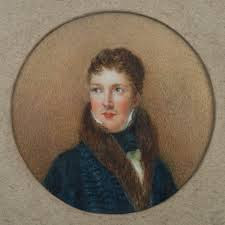
Everyone who has an interest in either the Duke of Wellington or the Battle of Waterloo has heard of Henry Percy, above, the officer sent from Brussels to London on a mission to deliver Wellington's Waterloo Despatch - the official report that would unquestionably confirm the Allied victory at Waterloo.
PERCY, HENRY (1785–1825), colonel, aide-de-camp to Sir John Moore and to Wellington, fifth son of Algernon Percy, baron Lovaine, who was created Earl of Beverley in 1790, and brother of Hugh Percy [q. v.], bishop of Carlisle, and of Vice-admiral Josceline Percy, was born on 14 Sept. 1785. He was educated at Eton, and on 16 Aug. 1804 appointed lieutenant in the 7th fusiliers. He became captain unattached 9 Oct. 1806, and captain 7th fusiliers on 6 Nov. following. He was aide-de-camp to Sir John Moore at Coruña. On 21 June 1810 he was transferred as captain to the 14th light dragoons. He was taken prisoner with a party of his regiment during the retreat from Burgos in 1812, and was detained in France until the peace. In 1815 he was appointed aide-de-camp to the Duke of Wellington. He brought home the Waterloo despatches, arriving post in London on the evening of 20 June with the despatches and captured eagles, and was next day made C.B., and a brevet lieutenant-colonel from 18 June 1815. He retired on half-pay in 1821, and was returned to parliament for Beeralston, Devonshire, in 1823. Once a gay, handsome young fellow, he prematurely lost his health. He died at his father's house in Portman Square, London, 15 April 1825, in his fortieth year, and was buried in the cemetery of St. Marylebone. [Foster's Peerage, under ‘Beverley;’ Army Lists; Gent. Mag. 1825, pt. i. p. 567.]
Percy's ride was recently recreated for the 200th Anniversry of the Battle of Waterloo and many legends, romantic or otherwise, have arisen from the Duchess of Richmond's Ball, the Battle of Waterloo and Percy's famous ride. Below you'll see the uniform Percy wore to the Ball, during the Battle and for the duration of his ride to London - more from the Waterloo200 website here.
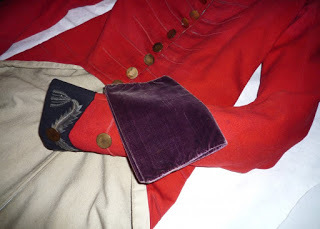
"This wallet or sachet of purple silk velvet and crepe, maker unknown, is traditionally said to be a lady’s handkerchief sachet. It played a vital role after the Battle of Waterloo, as it was in this case that the Waterloo Dispatch travelled back to London from Belgium. The Dispatch, carried by Major Henry Percy, was the Duke of Wellington’s account of the battle, and was the first news received by the British government of the Allied victory. The case is photographed on Major Percy’s uniform in which he fought at Waterloo."
What we have not heard before now are the details of Percy's journey to London and of the many others who played a part in the delivery of the Despatch. I've just finished reading Brian Cathcart's excellent account of the story behind Percy's ride and the many ways in which the Allied victory impacted Britain, English society and Europe as a whole.
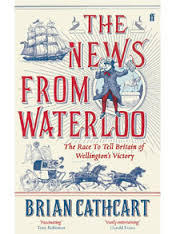
The News from Waterloo: The Race to Tell Britain of Wellington's Victory by Brian Cathcart
From the publisher:
"This is a tragi-comic midsummer's tale that begins amidst terrible carnage and weaves through a world of politics and military convention, enterprise and roguery, frustration, doubt and jealousy, to end spectacularly in the heart of Regency society at a grand soirée in St James's Square after feverish journeys by coach and horseback, a Channel crossing delayed by falling tides and a flat calm, and a final dash by coach and four from Dover to London.
"At least five men were involved in bringing the news or parts of it to London, and their stories are fascinating. Brian Cathcart, a brilliant storyteller and historian, has visited the battlefield, travelled the messengers' routes, and traced untapped British, French and Belgian records. This is a strikingly original perspective on a key moment in British history."
Cathcart uses Percy's ride as a platform to write about all manner of subjects related to Regency England - road travel, the telegraph, channel crossings, newspapers and banking, society and politics. The News From Waterloo is a vivid, entertaining read and should be a part of every Waterloo/Wellington/Regency library.
George the IV famously promoted Percy on the spot at the Boehm residence in St. James's Square once he'd delivered the Despatch and placed the French Eagles at the King's feet. What is lesser known is that Wellington himself acknowledged his debt to Percy by gifting him with a Breguet pocket watch. I urge you to read the full article on the watch which can be found here.
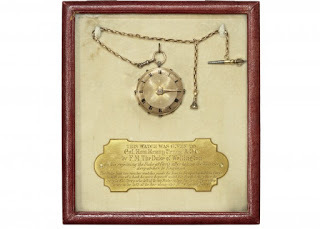
This is a pocket watch that belonged to Major Henry Percy, a British officer who fought at the Battle of Waterloo, and was chosen to deliver the Duke of Wellington’s dispatch back to London. Carrying news of the Allied victory at Waterloo to the British government was a vital task. In recognition of his work, the Duke of Wellington gave Major Percy this watch – made by the Parisian clockmaker Abraham-Louis Breguet, one of the most famous artisans of his time.
At the same time that Wellington bought Percy's watch, he also purchased one for himself. Wellington had his watch fitted with an extra cover that held a minature portrait. The lady in the miniature is Marianne Patterson. You can read more here.
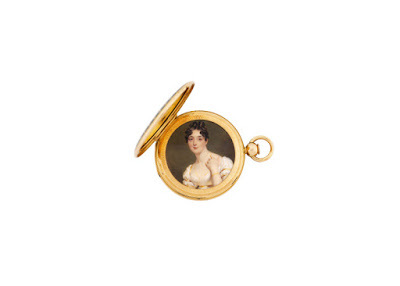
You can read the full Waterloo Despatch as it appeared in the London Gazette here.
You'll also find the link to Hugh Grant reading the Waterloo Despatch in the lefthand sidebar of this blog.
Published on July 26, 2015 23:30
July 24, 2015
THE WELLINGTON TOUR: DINNER AT THE GRENADIER
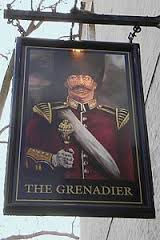
After spending our day steeped in All Things Wellington via visits to Apsley House, the Wellington Arch, the Tower and Horseguards, there really was no question as to how to end the day - with dinner at the Grenadier Pub, of course.
The Grenadier 18 Wilton Row Belgrave Square Knightsbridge London SW1X 7NR
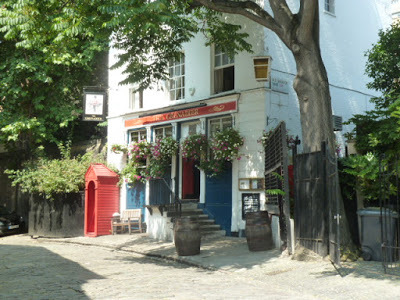
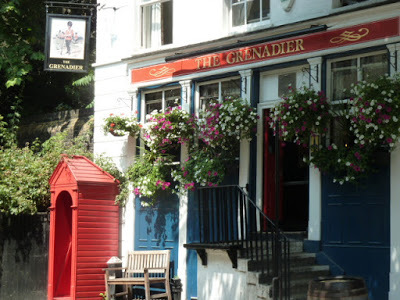
We've posted about the Grenadier in the past - here's link with some good background and history. Read this post and then return here to finish reading this post about our Tour dinner.
The Grendier is within walking distance of Apsley House and legend has it that the Pub was used as a mess by soldiers in the Duke of Wellington's regiment, although a pub in some form has stood on the spot since 1720.
The Grenadier's military connection is not in doubt. Until 1834, Old Barrack Yard, the remnants of which run along the side of the Grenadier Pub, once formed the access road to Knightsbridge Foot Barracks, located on the site now occupied by St. Paul's Church, Wilton Place. When the Guards moved to their current home at Wellington Barracks in Birdcage Walk, the land was donated by the owner, the Duke of Westminster, to the Diocese of London.
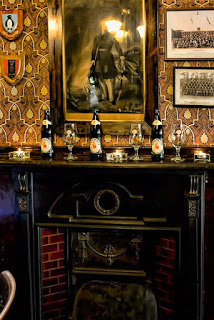
The interior of the Grenadier is lined with Wellington, Waterloo and military memorabilia. Above the fireplace is an engraving of Wellington that is part of a series of pictures depicting the highlights of Wellington's life. They were printed in 1852 and all feature rosewood frames. The print I have depicts Wellington in his Oxford robes as Chancellor of the University.
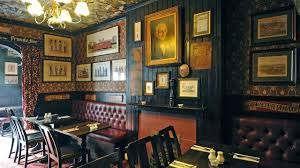
The bar area, below, is truly cozy, but they serve a variety of beer on tap, mixed cocktails and, of course several types of port.
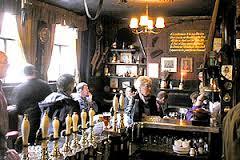
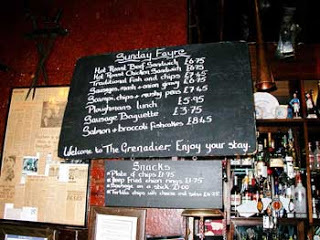
The dinner itself was fabulous. I remember that much. There was soup, as you can see . . . .
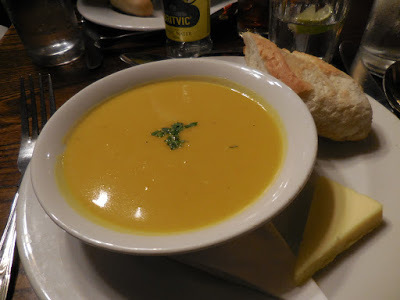
As well as something beneath what appears to be a Yorkshire pud, along with mashed potatoes and peas and carrots.
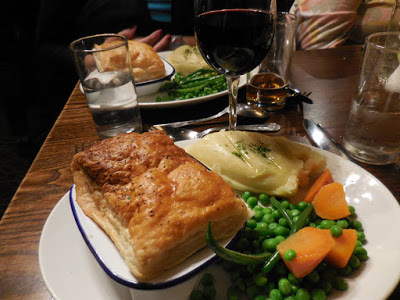
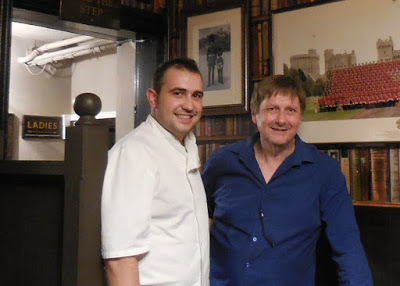
Our tour group was treated like royalty by the Grenadier's Manager, Tony Whitehead, and his excellent chef.
After a lovely meal, we all took time to explore the prints, ephemera and bookshelves that line the rooms at the Grenadier.
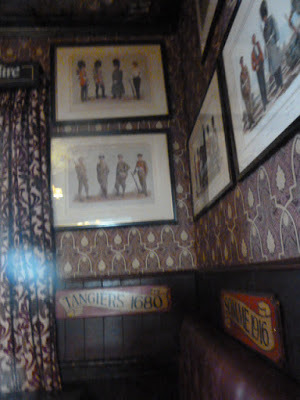
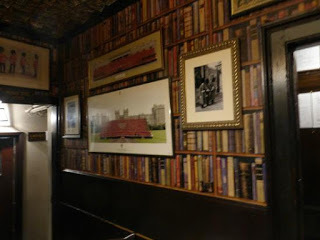
As in all good pubs, the ceiling at the Grenadier is lined with money stuck there by past guests. Most of it is British, but there are examples from all over the world, as well.
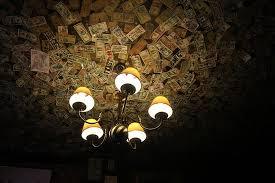
And finally, Kristine, Denise and Diane indulged in an taking the always flattering selfie.
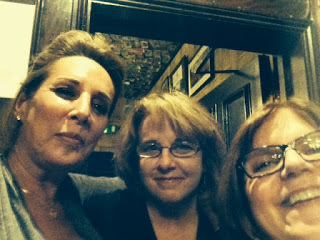
Much More Wellington Tour to Come!
Published on July 24, 2015 00:30
July 22, 2015
NAPOLEON'S FAMILY AFTER WATERLOO
NAPOLEON’S FAMILY
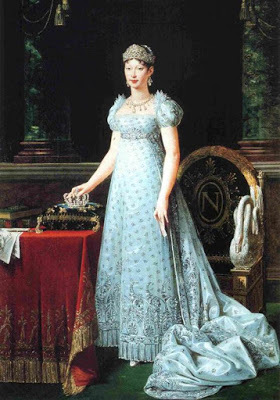 Marie-Louise, Duchess of Parma 1791-1847
Marie-Louise, Duchess of Parma 1791-1847Empress Marie-Louise (1791-1847)Marie-Louise was the oldest child of Austrian ruler Francis I. When Napoleon chose her as his second wife in 1810, there was a lull in the continental battles between France and Austria and her allies. The year after the wedding, Napoleon’s only legitimate son was born, Napoleon II, immediately given the title of King of Rome.
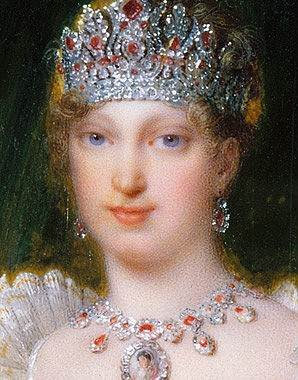
Marie-Louise was awarded the Duchy of Parma and other territories in the settlement after Napoleon's first abdication in 1814. She fled home to Vienna with her son, never to see her husband again. The attendant on her flight, Count Adam Albert von Neipperg, later became her second husband and father of her three more children. After Neipperg’s death, her third husband was another chamberlain, Count Charles Rene de Bombelles. Both of these men had been placed in her entourage by Metternich, perhaps to keep her occupied and away from meddling in Austrian politics? Marie-Louise ruled as the Duchess of Parma until her death.
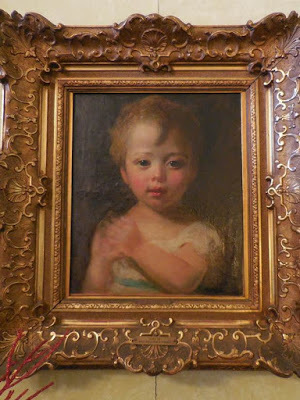
Napoleon II, as infant, studio of Sir Thomas Lawrence
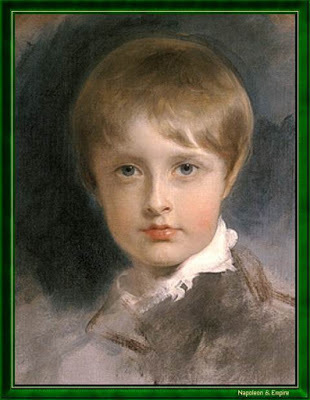 Francois Charles Joseph Napoleon II, King of Rome, Duc de Reichstadt by Sir Thomas LawrenceFogg Art Museum, Harvard University
Francois Charles Joseph Napoleon II, King of Rome, Duc de Reichstadt by Sir Thomas LawrenceFogg Art Museum, Harvard UniversityNapoleon II (1811-1832) was known in Austria as Franz, Duke of Reichstadt. He received military training and served as a cadet in the Austrian Army at a young age. However, both his grandfather, the Emperor Francis I, and Minister Metternich opposed any serious position for the heir of Bonaparte.
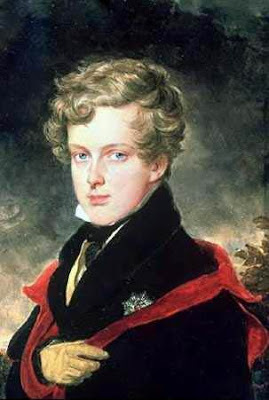 Franz, Duc de Reichstadt, 1811-1832
Franz, Duc de Reichstadt, 1811-1832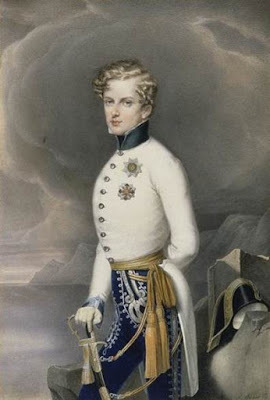
In 1831, the Duc de Reichstadt received a commission as head of a battalion, but he died soon thereafter of tuberculosis. He was twenty-one years of age.
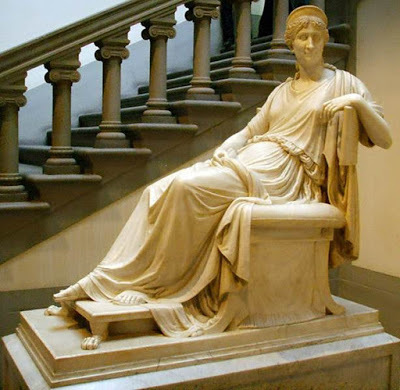
Letizia Ramolino Bonaparte 1750-1836, sculpture by Canova
Napoleon’s mother Letizia lived in Rome with her younger brother from 1815 to her death. Napoleon's father, Carlo Maria Buonaparte, had died of stomach cancer in 1785.
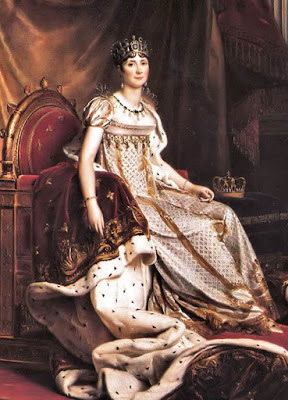 Josephine de Beauharnais Bonaparte 1763-1814
Josephine de Beauharnais Bonaparte 1763-1814The divorced first wife of Napoleon, Josephine, died in 1814 at Malmaison after walking in her famous gardens with Tsar Alexander I of Russia. Supposedly she caught a chill.
Since Napoleon II died without issue, the Emperor of France had no direct descendants. However, the Empress Josephine is an ancestress of several current royal families, including Sweden, Belgium, Norway, Denmark, Luxembourg, and Greece,
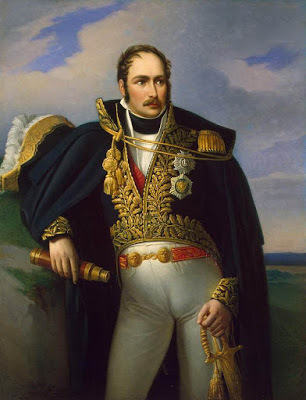 Eugène Rose de Beauharnais (1781–1824)
Eugène Rose de Beauharnais (1781–1824)Eugène de Beauharnais was the son of Josephine and her first husband Alexandre de Beauharnais, who was guillotined in the Terror. Napoleon adopted Eugène, and appointed him to command the Italian Army, which he commanded in the Russian campaign. He led the remainder of the army out of Russia in 1813, then fought in several more battles that year. When Napoleon abdicated the first time, Eugene moved to Munich with his wife, the daughter of King Maximilian of Bavaria. He died as Duke of Leuchtenberg and Prince of Eichstatt in 1824.
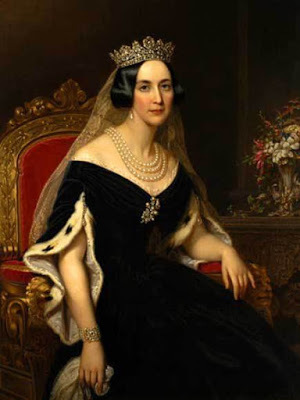 Queen Josephine of Sweden (1807-1876)
Queen Josephine of Sweden (1807-1876)Eugene’s daughter, Princess Josephine of Leuchtenberg, married Oscar Bernadotte in 1823, who became Oscar I, King of Sweden, upon the death of his father King Charles XIV, a former Napoleonic general known as Count Jean-Baptiste Bernadotte until he was chosen as the Swedish Crown Prince in 1810.
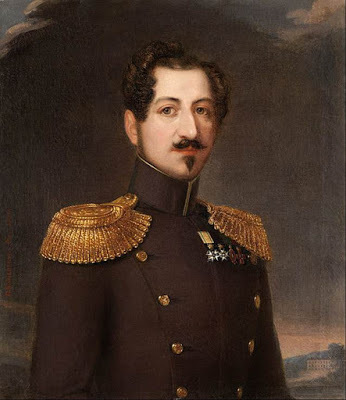 King Oscar of Sweden (1799-1859)
King Oscar of Sweden (1799-1859)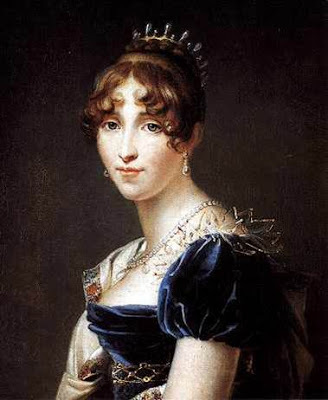 Hortense Beauharnais, Queen of Holland (1783-1837)
Hortense Beauharnais, Queen of Holland (1783-1837)Hortense (1783-1837), Josephine and Alexandre’s daughter, was also adopted by Napoleon. She married Napoleon’s younger brother Louis (1778-1846), King of Holland in the years 1806-10. Their son became Napoleon III (1808-1873) Emperor of the French in the years 1852-1870. He died in exile in England in 1873.
In 1814, Hortense was created Duchess of Saint-Leu but after supporting her stepfather in the Hundred Days, she had to leave France. She lived in Switzerland from 1817 to 1837. Louis also lived in exile but separately from Hortense; their marriage, forced upon them, had never been a happy one.
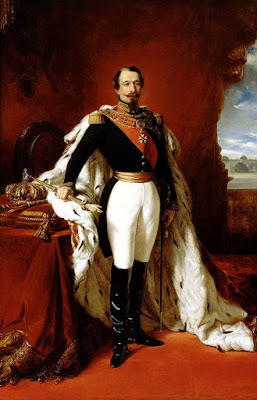 Napoleon III (1808-1873)
Napoleon III (1808-1873)Napoleon III, Emperor of the Second French Empire, was the nephew of Napoleon I. He was born to Hortense and Louis as Louis-Napoleon. He became president of the 2nd French Republic in 1848, then Emperor four years later. He was captured by the Prussians in 1870 and exiled to England for the rest of his life.
Napoleon I ruled most of his siblings' lives in regard to marriage as well as profession. His eldest brother Joseph (1768-1844) was first installed as King of Naples (1806-1808), then Napoleon demanded Joseph take over the embattled throne of Spain, from which he was driven out (1808-1813).
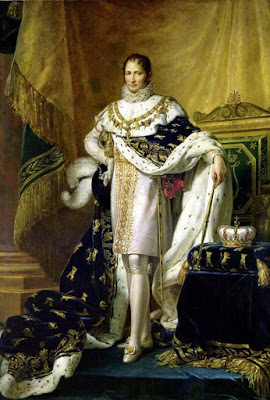 Joseph Bonaparte, King of Spain, 1808 by Francois Gerard
Joseph Bonaparte, King of Spain, 1808 by Francois GerardJoseph lived in the U.S. from 1817 to 1832, in New Jersey, near Bordentown. He returned to Europe and died in Florence Italy in 1844.
Lucien Bonaparte (1775-1840) was the third brother, one who avoided a royal name until after Napoleon's first restoration. Early on, he was a dedicated republican but nevertheless assisted Napoleon in gaining power.
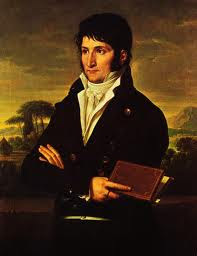 Lucien Bonaparte by Fabre
Lucien Bonaparte by FabreIn his later life, he was an active archaeologist. He married twice and had a total of thirteen children.
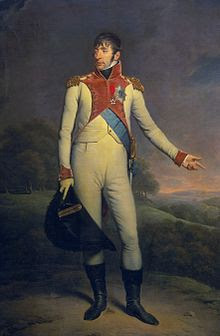 Louis Bonaparte, King of Holland
Louis Bonaparte, King of HollandThe fourth brother Louis Bonaparte (1778-1846) became the King of Holland 1806-1810(see above).
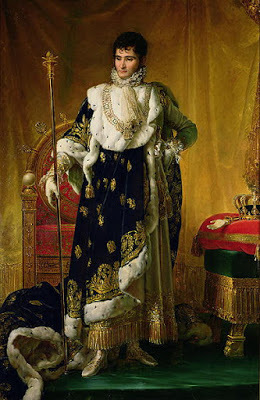 Jerome Bonaparte by Gerard
Jerome Bonaparte by GerardThe youngest (fifth) brother to survive infancy, Jerome (1784-1860), was King of Westphalia (1807-1813). In 1803, he married Elizabeth "Betsey" Patterson (1785-1879) in Baltimore, Maryland.
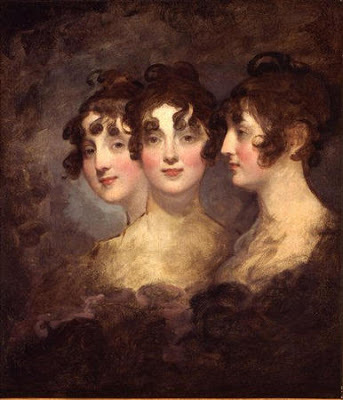 Elizabeth Patterson Bonaparte 1804, triple portrait by Gilbert Stuart
Elizabeth Patterson Bonaparte 1804, triple portrait by Gilbert StuartNapoleon was outraged and ordered Jerome back to France to begin annulment and/or divorce proceedings. Betsy, now pregnant, came with him and they attempted to land in France but were turned away. Jerome went to Italy to reason with his brother Joseph. Meanwhile Betsey went to England where her son, Jerome Bonaparte II was born. Betsey and Jerome never saw one another again.
Jerome considered the marriage annulled and actually married again, but Betsey continued working for a divorce from him which she was granted in Baltimore in 1815. Betsey's sister-in-law Marianne Caton Patterson, in a strange turn of events, later went to Europe with her Caton sisters and enjoyed an active social life. Though Marianne was admired by the Duke of Wellington, she chose to marry his elder brother, Richard, 1st Marquess Wellesley, in 1825, as his second wife. Though it was not known as a happy marriage, it endured until his death in 1842. Marianne (or Mary Ann as it is sometimes spelled) became a Lady of the Bechamber to Queen Adelaide in 1830.
Betsey lived to age 92, and died in Baltimore in 1879. Jerome Bonaparte II (1805-1870) married and had two sons, one of whom, Charles Joseph Bonaparte (1851-1921), served as U.S. Attorney General and Secretary of the Navy.
The eldest of Napoleon's three sisters was known as Elisa (1777-1820). At various times in her life she was the Princess of Lucca nd Grand Duchess of Tuscany. She was married to a Corsican noble Felice Pasquale Baciocchi (1762-1841), who took the surname Levoy. They had four children, two of whom lived to adulthood. She preceded Napoleon in death.
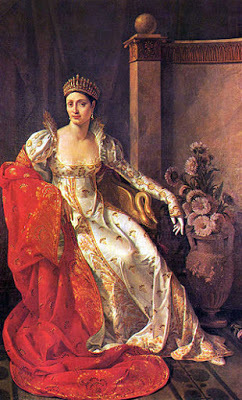 Elisa Bonaparte, Grand Duchess of Tuscany
Elisa Bonaparte, Grand Duchess of TuscanyPauline Bonaparte, Princess Borghese, with their mother, supported her brother on Elba in his exile, also lived in Rome after 1815. She and her first husband, one of Napoleon’s generals, had one child, a son who died at age six.
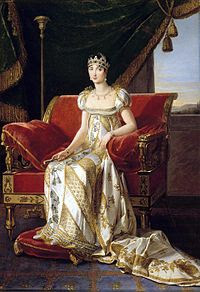 Pauline Bonaparte
Pauline Bonaparte With her second husband, Prince Borghese, she had no children. Pauline died at age 45 of tuberculosis. For more on her life, see the wonderful report on her found on Elizabeth Kerri Mahon’s blog, here.
Caroline Bonaparte (1782-1839) was the youngest of the sisters of Napoleon who survived infancy.
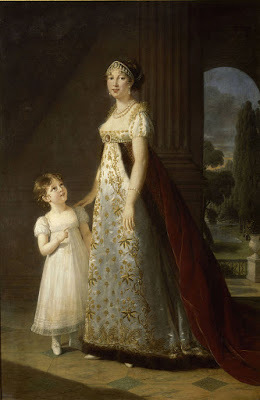 Caroline Murat and daughter, 1807, by Elisabeth Vigee-Lebrun
Caroline Murat and daughter, 1807, by Elisabeth Vigee-LebrunCaroline was married to Joachim Murat, a French general. Among other titles, she became the Queen of Naples in 1808 when her husband succeeded his brother-in-law Joseph on the throne. When Murat declared for Napoleon during the hundred days in 1815, he was deposed and executed. Calling herself Countess of Lipona. she lived in Austria and married again in 1830.
Of her four children with Murat, the eldest, Achille Charles Louis Napoleon Murat (1801-1847) lived in the United States, Florida in particular, where he died without issue.
Current head of the House of Bonaparte is Charles, Prince Bonaparte, b. 1950, who lives in France. He is a descendant of Jerome Bonaparte.
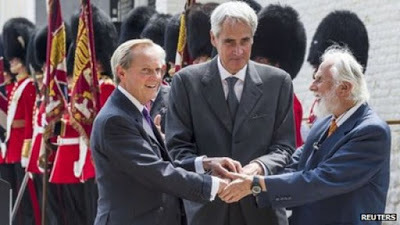 \June, 2015
\June, 2015 Descendants of the three commanders shake hands at the Waterloo battlefield. L-R, 9th Duke of Wellington, Prince Charles Bonaparte, and Prince Blucher von Wahlstatt, observing the bicentenary of the great battle and remembering the thousands who died.
And finally there is Jean-Christope Bonaparte, Napoleon's great-great-great-great-nephew through his brother Jerome and who apparently got his looks from the Canova statue of Napoleon. His father is seen in the photo above. A number of the crowned heads of Europe consider Jean-Christophe to be Head of the former Imperial House of France and heir to Napoleon's legacy.
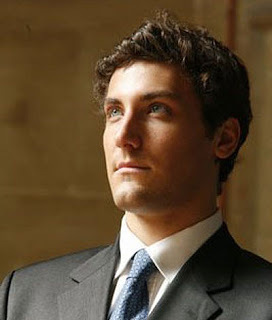
Published on July 22, 2015 00:30
July 19, 2015
THE PELL MELL THEATRE COMPANY STAGES TWELFTH NIGHT AT CANARY WHARF
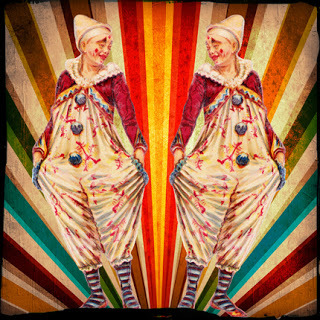
Twelfth Night By the very fangs of malice I swear, I am not that I play…
Pell Mell Theatre Company are delighted to announce their upcoming production of "Twelfth Night" at the Space Theatre. In his decadent, decaying music hall Orsino, a maniacal master of ceremonies, is desperate to pull his former leading lady Olivia, lost in a sinkhole of depression, back onto the stage and into his arms. The only one who can bring a smile back to her face is Orsinoʼs newest recruit, the clown Cesario, a youth with remarkable talents, not only for avoiding uncomfortable questions about the past but also, it seems, for appearing in two places at once…
Using Shakespeareʼs stunningly lyric text alongside a wide range of live music, dance and circus performance Pell Mell presents a bold, boisterous exploration of love, madness and identity as storms rage, families break apart and a steward called Malvolio comes to regret his choice of stockings!
Director Natalie York says "Shakespeare's text is packed so full of music, magic and deception, for us it fitted perfectly in the world of a theatre where no one is quite who they say they are or what they want to be. The hierarchies, petty jealousies and wild emotions that drive this twisted, brilliant comedy take on a new sense of reality and absurdity amongst gossiping showgirls, arrogant leading ladies, unpredictable clowns and obsessive fans."
Pell Mell Theatre Company brings its trademark extravagant style to bear on this rich, multifaceted play. Working with the best emerging designers and composers to draw back the curtain on a living, breathing Victorian theatre, from the opulent productions to the grimy backstage nooks and crannies. Off West End Award nominated choreographer Thomas Michael Voss will be masterminding a dazzling range of dances, acrobatics and variety entertainment to bring every moment thrillingly to life.
Committed to bringing large-scale productions to the world of fringe theatre, Pell Mell creates shows that tackle classic texts with vibrancy and nuance. Past productions have included "A Midsummer Night's Dream" and "The Duchess of Malfi" which received 5* and 4* reviews at The New Diorama Theatre in 2014. The company also has a strong history of collaboration with various charities, including Rape Crisis and Mind UK, and relaxed performances are included as an important part of each production, where a comfortable and engaging environment is provided for audiences with mental health difficulties.
“Twelfth Night” will mark Pell Mell Theatre Companyʼs fifth London production and first time at The Space Theatre in Canary Wharf.
Praise for Pell Mell Theatre Company A totally engrossing production…
if you see any fringe theatre this year this is it! Whatʼs On London * * * * *
A triumphant gem of a production! A classic period piece that effortlessly bridges the original era and the modern day Everything Theatre * * * *
An excellent, deliciously dark production London Theatre One Shows taking place at The Space Theatre 269 Westferry Road, London E14 3RS Dates: Tues 21st July – Sat 8th August, 7:30pm (excludes Mondays & 31st July – 1st August)
Tickets: £14/£10 Book tickets via www.camdenfringe.com
Press contact: Sophie Tuck telephone: 07880912242 email: theatre.pellmell@gmail.com
Published on July 19, 2015 23:00
July 17, 2015
THE DUKE OF WELLINGTON TOUR DAY ONE, CONTINUED: THE TOWER OF LONDON
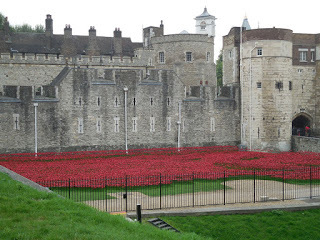 Heading for the entrance
Heading for the entrance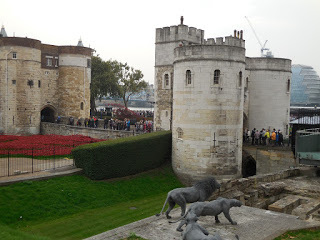 The remainder of the former menageries: sculptured lions
The remainder of the former menageries: sculptured lions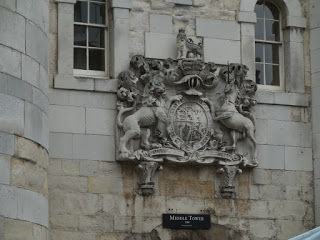
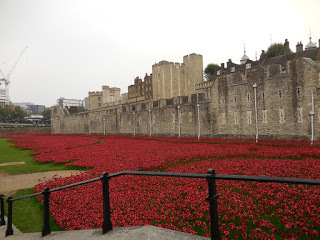
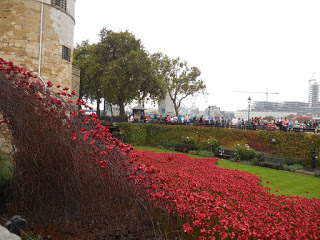
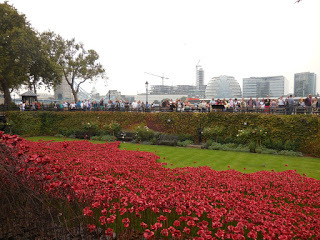
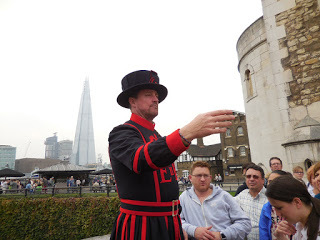 Our Guide, a Beef Eater aka Yeoman Warder
Our Guide, a Beef Eater aka Yeoman WarderHe explained to us the significance of the wonderful display of hand-made ceramic poppies. One was cast for each person killed from Great Britain and the Commonwealth, almost 800,000, to be place on around the Tower of London by the anniversary of the conclusion of World War I on November 18, 1818. It was, he pointed out to us in September 2014, one hundred years since the beginning of the Great War, or, as he slyly added, "For you Americans, 97 years!"
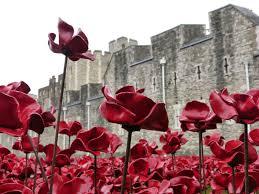 Each poppy is hand-made
Each poppy is hand-made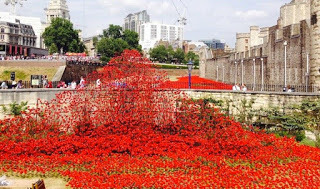 The final spray of poppies, to be preserved,by popular demand
The final spray of poppies, to be preserved,by popular demandFor more information about the art installation Blood Swept Lands and Seas of Red, click here.
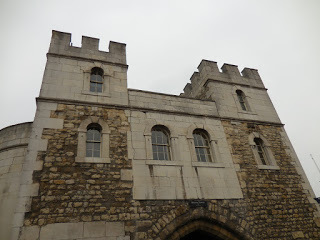 Kristine and I soon abandoned the tour and struck out to find the Wellington Exhibitionas advertised on large posters around London. Example below.
Kristine and I soon abandoned the tour and struck out to find the Wellington Exhibitionas advertised on large posters around London. Example below.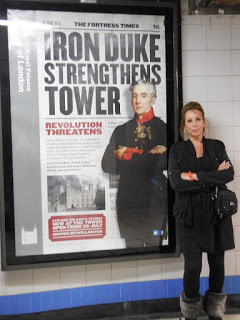 As you can imagine we were eager to see this exhibition at the Tower.
As you can imagine we were eager to see this exhibition at the Tower. We started out assured by a guard we would find it if we just kept going...
We started out assured by a guard we would find it if we just kept going...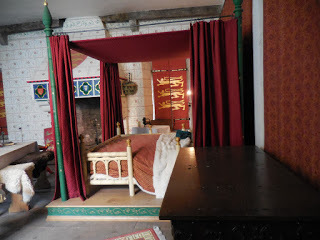 We didn't even stop to see whose bed this was.
We didn't even stop to see whose bed this was.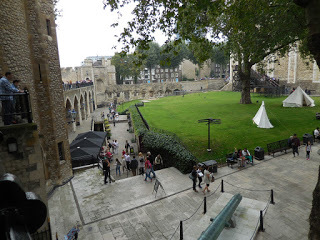 We squeezed through cramped corridors and around one narrow curving staircase after another. and often peeked through windows and arrow slits.
We squeezed through cramped corridors and around one narrow curving staircase after another. and often peeked through windows and arrow slits.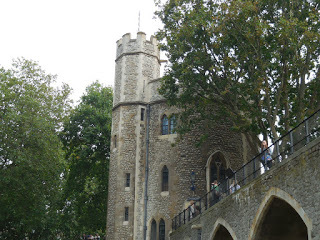 Farther and farther...
Farther and farther...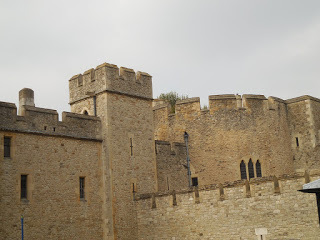 Ar least we got a good view of the nooks and crannies of the Tower ramparts
Ar least we got a good view of the nooks and crannies of the Tower ramparts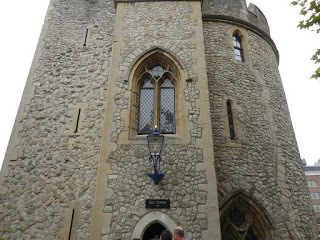
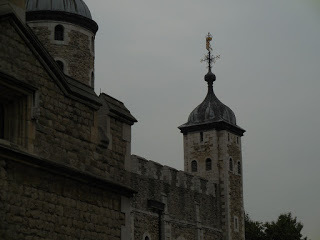
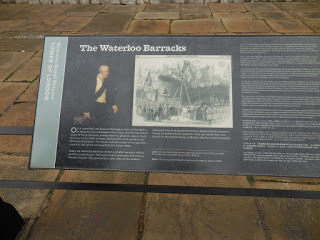
"On 15 June 1845, the Duke of Wellington, hero of the Battle of Waterloo and Constable of the Tower, laid the foundation stone of these barracks, named after his greatest victory. Built to house up to 1,000 soldiers, the barracks were designed by the Royal Engineers, The soldier outside is part of the garrison tradition, still active and guarding the Tower today.Today, the Waterloo Barracks contain a smaller barracks, offices and the Jewel House. The building also overlooks the military Parade Ground. The ceremonial public duty of the soldiers stationed here is to guard the Crown Jewels and the Queen’s House on behalf of the monarch. They can come from any branch of the armed forces of Britain and the Commonwealth."
The text panel above was repeated in ten additional languages
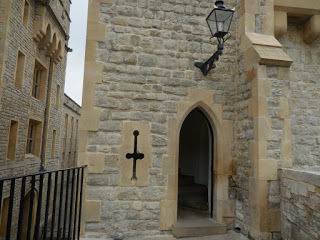 Hot on the Trail: we're almost there. \\
Hot on the Trail: we're almost there. \\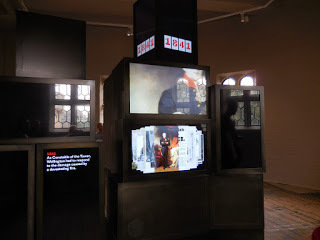 Sucess. But this is all there was, a set of images including the equivalent of a power-point show. We found The Wellington Exhibition at the Tower completely underwhelming.
Sucess. But this is all there was, a set of images including the equivalent of a power-point show. We found The Wellington Exhibition at the Tower completely underwhelming.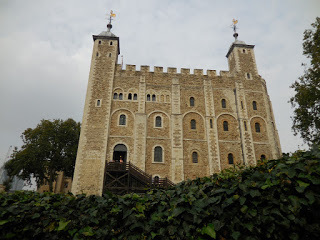 The White Tower
The White Tower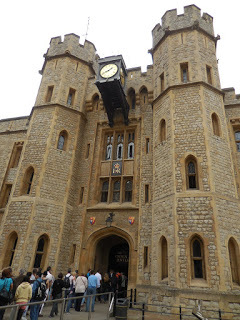 the line for the Crown Jewels
the line for the Crown Jewels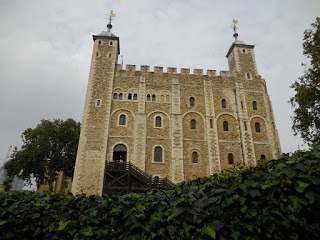
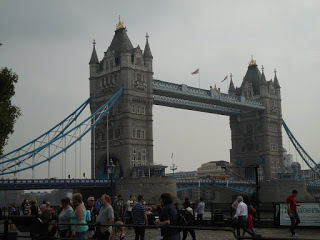
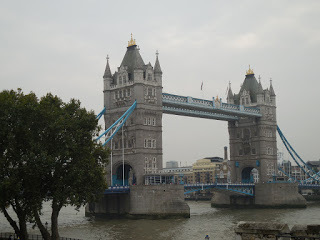 Tower Bridge
Tower Bridge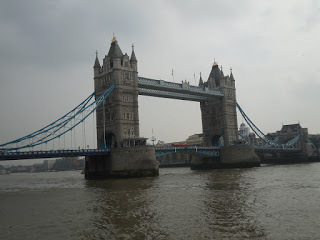
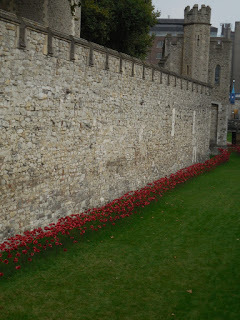 Where the poppies were just beginning to be placed
Where the poppies were just beginning to be placed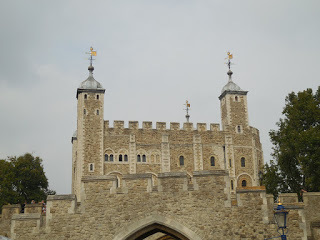 The White Tower
The White Tower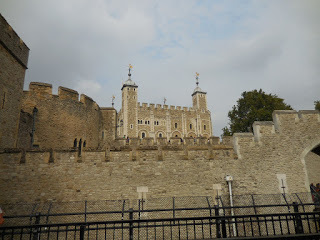 A distant view of the White Tower
A distant view of the White Tower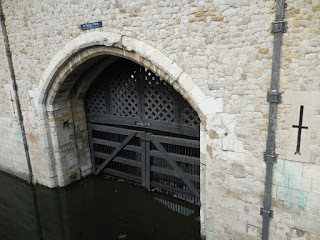 The Traitor's Gate
The Traitor's Gate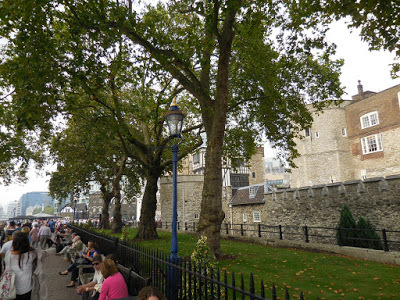 The wall along the Thames
The wall along the Thames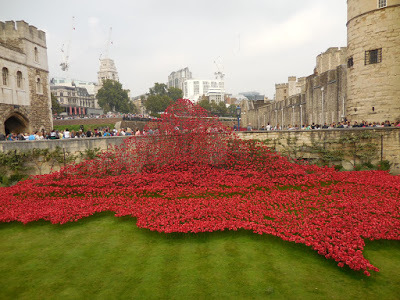 The poppies from the west
The poppies from the westSeeing the poppies was the highlight of the visit to the Tower. And we did negotiate the entire circumference of the place, up and down, in and out, ad nauseum, with a disappointing result. Actually, in retrospect it was pretty amusing to think of the long trek when we could have simply walked through the lawns and found the Wellington Barracks instead of going the long way around. And since Kristine is an expert on Wellington, and I am not so bad myself (says Victoria immodestly), what did we think we would learn? I guess we were hoping for a tidbit of new materials. To no avail!
On the plus side, we got some exercise, some good shots of the Tower, and a very memorable view of those incredible poppies.
Next, we re-crossed London to Horse Guards in Whitehall for the Afternoon Ceremonies.
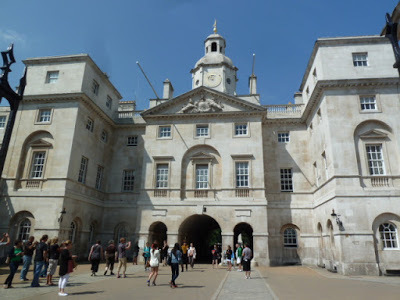 Horse Guards
Horse GuardsThe Horse Guards building, which served as the British Army's headquarters for many years, was designed by William Kent (1685-1748) and built by John Vardy between 1750 and 2753. It is a masterpiece of the Palladian style. The Duke of Wellington occupied offices here for a large part of his life.
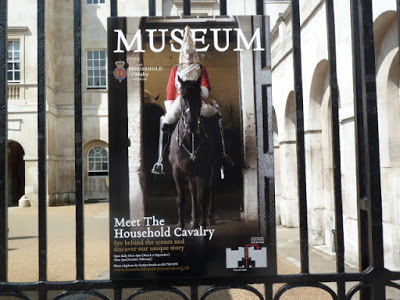
Two mounted guards from the Household Cavalry are in place every day and a great attraction for the tourists along Whitehall. Each afternoon, the Daily Inspection takes place at 4 pm.
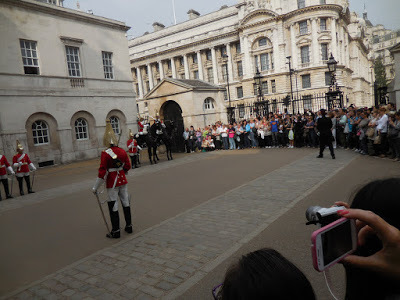
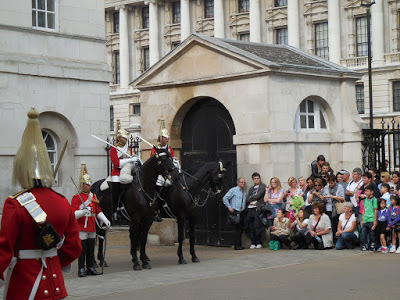
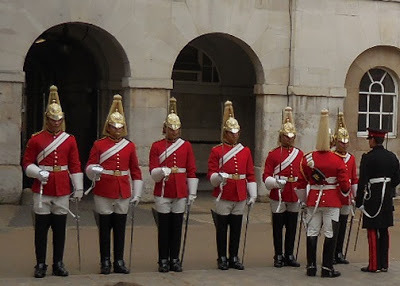
Following the Inspection, we toured the Household Cavalry Museum, which opens onto the Parade Ground behind the building. Their Website is here.
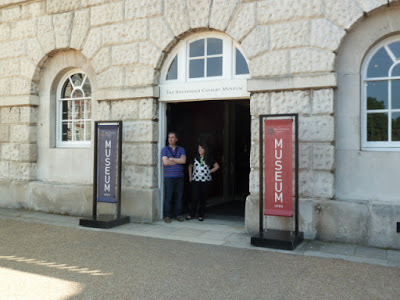
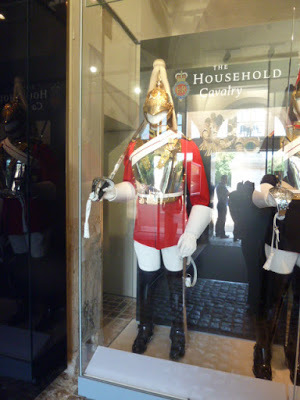
By this time, we were ready for a return to the hotel for a rest before our special dinner at The Grenadier, which we will describe next week.
Published on July 17, 2015 00:30
Kristine Hughes's Blog
- Kristine Hughes's profile
- 6 followers
Kristine Hughes isn't a Goodreads Author
(yet),
but they
do have a blog,
so here are some recent posts imported from
their feed.



